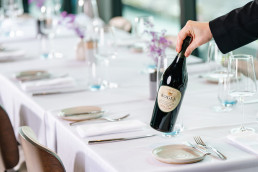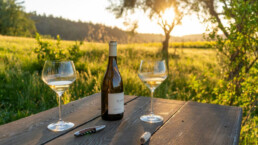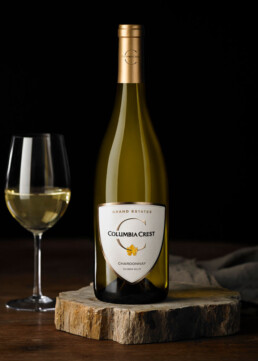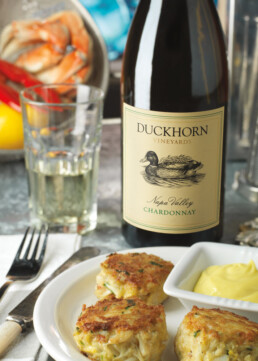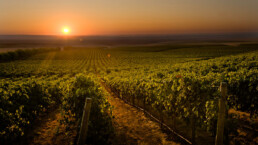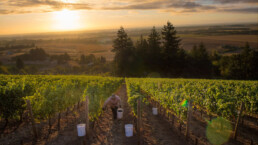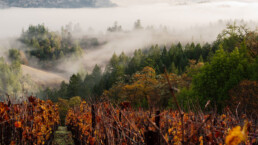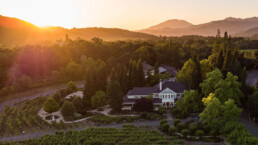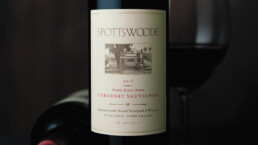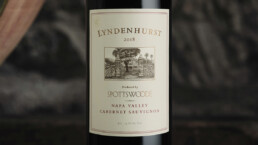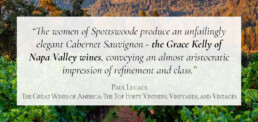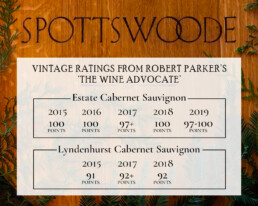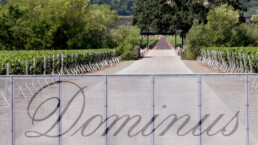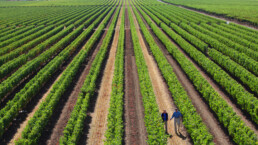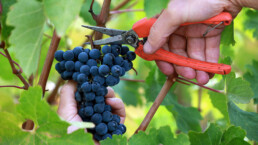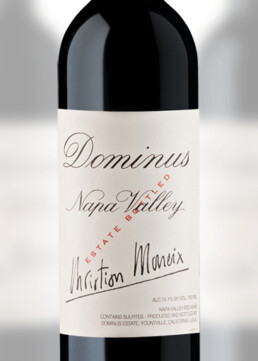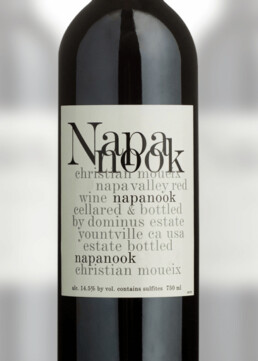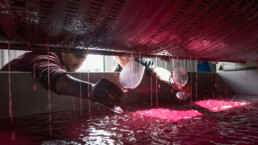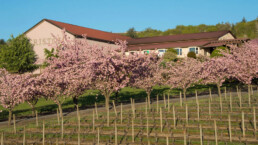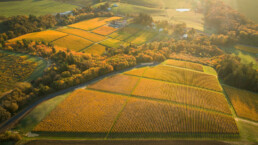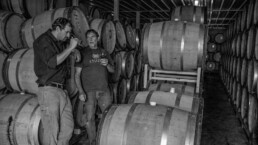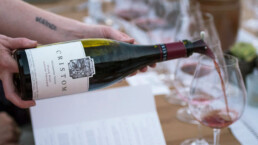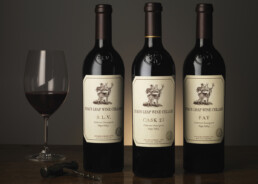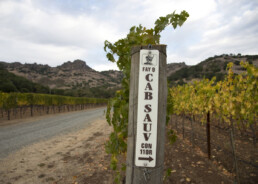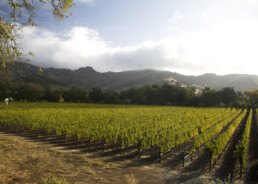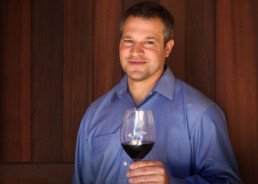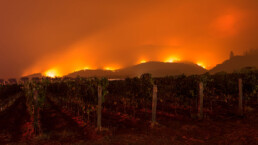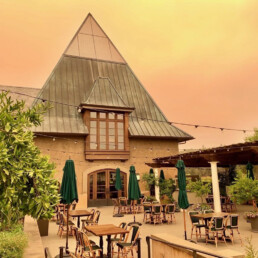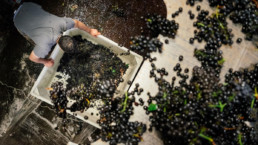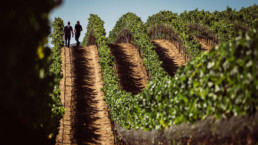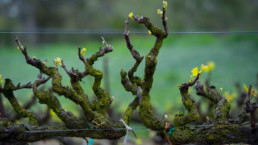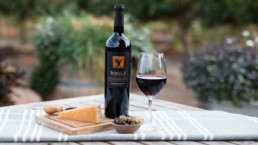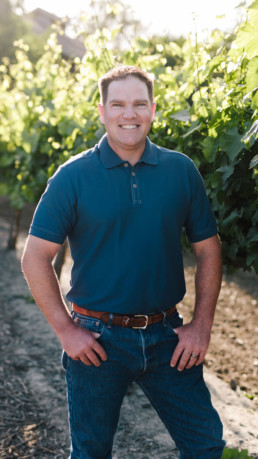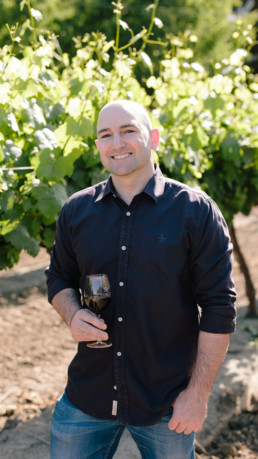Sip 'n' Savour - A Bogle Wine Dinner 15 Storeys Up
Join Harbour Society, Farro & Dhall & Nash for a journey to the sunny valleys of California, 15 floors above Auckland City with a wine dinner like no other at SO/ Auckland.
Enjoy a three-course dinner while you sip, swirl and savour handpicked wines by the Californian wine sensation - Bogle Family Vineyards. Jody Bogle - the sixth generation of the family working their land - will be joining via a live video feed to chat and answer any questions you may have about their wine, their history and their vineyards.
Bogle is a tried-and-true favourite in New Zealand, opening the eyes of many a kiwi to the delights of bold Caifornian Chardonnay, but this producer has more arrows in its quiver than just this liquid gold. Come along and try more from their impressive range (as well as their famous chardonnay!)
A table with sweeping views of Auckland city, fragrant food and delicious wine will set the scene among good company (and maybe even a few prizes).
- Date: Thursday, 21st November 2024
- Time: 6:00pm (doors open 5:30pm)
- Location: Harbour Society at SO/ Auckland
- Cost: $99.00 per person
Wave the Flag - it's the 4th of July
Wave the Flag - it's the 4th of July
12 Star-Spangled Awesome American Wines for Independence Day

It’s the 4th of July just around the corner — yessiree, Happy Birthday, America! — so what better way to celebrate than with a few fabulicious American wines.
Proudly, right from our earliest days, Dhall & Nash understood the bounty and calibre of American wines. We were amongst the first in NZ to hitch our wagon to the vinous rockstars of USA.
Our super selection from the great states of California, Oregon, and Washington is now considered to be as jaw-dropping as any 4th July fireworks display.
And what better way to celebrate with a full stars and stripes experience, than to team these wondrous wines with some All-American recipes for you’all to chow down for your Independence Day blow-out bashes.
Arguably the most famous 4th of July food tradition is the all-American barbecue, which brings many American families and friends together around a grill, not too dissimilar to our Kiwi Barbie!
When we think of the perfect 4th of July menu, there’s a few things that come to mind. You’ve gotta have the classics, like burgers and hot dogs, ribs, and potato salads, of course, but let’s do a little kiwi-Americana mash-up to add some pizazz to your festive BBQ menu. Here’s some Dhall & Nash Independence Day inspiration! Have fun!
We hope there’s something in our selection that’s tickled your tastebuds… if not search through our extensive wine catalogue for your perfect American wine – red, white, and blue-chip.
Cheeky Disclaimer – our D&N food and wine pairing “truth” is, you can eat pretty much whatever you want while drinking whichever wine you choose. So here’s some of our suggestions – but you go for it whichever way you darn well want!
Chili Dogs
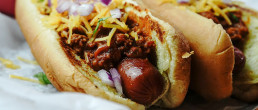
- 1 Can of Whole Tomatoes,
- 1 tbsp. Chili Powder,
- 2 tsp. Ground Cumin,
- 1 medium Red Onion (finely chopped),
- 4 Tbsp Tomato Paste,
- Black Pepper & Salt to taste
- 500g. Ground Mince
- 4 Hot Dogs
- 4 Hot Dog Buns
- 1 cup. Grated Sharp Cheddar,
- 4 Good quality Pickles
Place the tomatoes, paste and their juices in a large casserole pot or slow cooker, breaking them up as you add them. Stir in the chili powder, cumin, all but 3 tablespoons of onion, and 1/2 teaspoon pepper; keep the remaining red onion for the top of hot dogs at the end.
Add the beef, break it up and stir to combine. Cook, covered, until the meat is cooked through, and liquid begins to reduce, about an hour (Or longer if you want a thicker sauce).
Fifteen minutes before serving, add the hot dogs to the top of the slow cooked mince and simmer, covered, until heated through. Divide the hot dogs among the buns and top with the chili, Cheddar, and remaining chopped onion. Serve with pickles, if desired.
First up to bat is the quintessential American Chilli Dog. We’ve paired this family fave with a Washington State dark-fruited Syrah. Equally as scrumptious, try this Hot dawg with the Cali classic Petite Sirah. It’s hard to beat California when it comes to PS that’s dangerously drinkable like this! Both these wines have flavours enhanced by bold spices like chili pepper, cumin, and rich tomato.
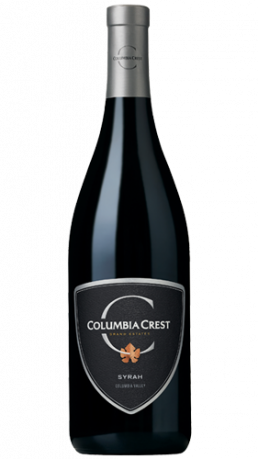
Columbia Crest Syrah 2019
“The aromas are unmistakably Syrah, with notes of plum and smoked meat. Plump, very primary fruit flavors follow, with a creamy feel from the barrel. It’s tasty and a good value to boot.”
89/100 points – Wine Enthusiast
“Good typicality – violet and blackberry with plush notes. Nice expression of Syrah layered and structured tannins. On the sweet side but packed full of fruit and spice. Well made, very commercial and good value”
16/20 points – Jancis Robinson.com
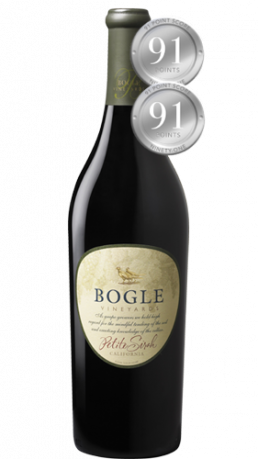
Bogle Petite Sirah 2018
Although everyone adores Bogle Chardy, their reds are awesome too! But don’t confuse this with Syrah; although they are related, genetically being a cross between Syrah & Peloursin – and btw it also goes by the name “Durif” in France.
“As deep as black hair dye in colour. Sweet clove spice on the nose. Very ripe fruit, but it doesn’t meld with the oak particularly well. Long, sweet-fruited finish. Not without a certain charm, but in a very loud-mouthed way.”
16/20 points – JancisRobinson.com
“Delicious blackberry, blueberry and dark-chocolate flavors are wrapped in thick but soft tannins. This is a full-bodied wine, with a mouthcoating texture.”
91/100 points – Wine Enthusiast
Buffalo Wings
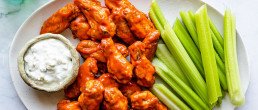
- 1kg chicken nibbles
- 3 Tbsp butter, melted
- 4 Tbsp your favourite Hot Sauce
- 1 Tbsp paprika (smoked is best)
- 3 Tbsp brown sugar
- 1/2 teaspoon salt
- 1/4 teaspoon black pepper
Marinate the chicken nibbles for 30mins and either bake in the oven or BBQ. Be sure to reserve some of the marinade to baste the chicken. Pair these with Blue Cheese Dip.
Hot tip – how to make ultra-crispy Buffalo Wings in the Oven… Here’s 2 cheeky secrets to follow:
- Baking powder (believe it or not – yes!) – pat dry your wings, then toss the wings in baking powder which draws moisture to the surface of the skin and helps make it crispy; and
- bake on low then high – usually, the fat under the skin is part of the reason why baked wings don’t get really crispy. So, the secret is to start at a low temp first which melts the fat under the skin, then crank up the oven at the end which makes the skin super crispy!
- Blue Cheese Dip
- 1/2 cup sour cream
- 1/2 cup crumbled blue cheese
- 1/2 cup mayonnaise
- 1 Tbsp white wine vinegar
- 1 clove garlic, mince
Blend all the ingredients and scrape into a serving bowl.
To serve – arrange the wings on a platter, add a side of the dip and serve with CELERY sticks – yes, it’s like the perfect way to reboot your taste buds in between each wing!! And remember, plenty of paper towels for sticky fingers.
The conventional wisdom is that Pinot Noir pairs best with duck or mushrooms, but this grape is surprisingly versatile and will match a big range of different foods. Hence, we decided these two pinots will rock with old fashioned Buffalo Wings – who doesn’t love ’em. Even though they’re just kind of messy to eat, they’re totally worth it ☺ Btw – did you know that Buffalo wings are so called because they were first created in Buffalo, New York and definitely not made from buffalo meat!?
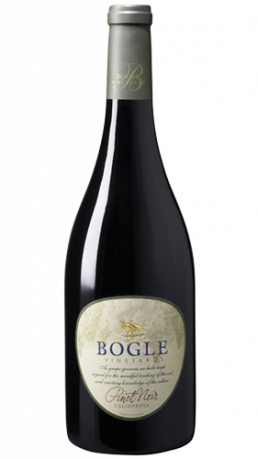
Bogle Pinot Noir 2020
On the 2019 vintage: “Rich black-fruit notes fill the aromas and flavors of this saturated and full-bodied wine. Gorgeous black cherry and blueberry flavors are wrapped in fine-grained tannins for a mouth filling effect.”
91/100 points – Wine Enthusiast
Voted #6 TOP 100 BEST BUY of 2021 Wine Enthusiast Magazine
“Heady scents of ripe summer strawberries make a lovely first impression, while hints of crushed violets and sweet dried herbs resonate on the nose. Refined and nuanced, the mouthfeel softens as layers of cherry fruit are wrapped in a comforting blanket of pipe tobacco and worn leather. The firm, yet lingering finish is perfectly balanced with touches of baking spices, fragrant fruit, and earth tones.” – Winery Notes (This is an elegant, classic Pinot Noir at an extremely wallet friendly price!).
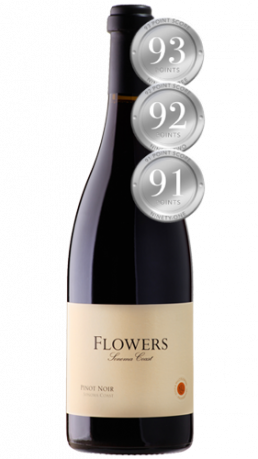
Flowers Sonoma Coast Pinot Noir 2019
“The 2019 Pinot Noir Sonoma Coast is deeper ruby-hued and has pure, classic, textbook notes of ripe cherries, raspberries, spring flowers, and underbrush. The balance is spot on, it has ripe, present tannins, good freshness, and a great finish.”
93/100 points – Jeb Dunnuck
Cheesy Cornbread
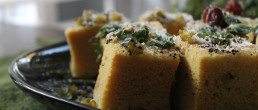
- 1 Cup yellow cornmeal (instant polenta ok)
- 1 Cup all-purpose flour
- 4 Tbsp sugar
- 4 tsp baking powder
- ½ tsp chilli powder
- ½ tsp salt
- 1 Cup milk or plain yoghurt
- 1 large egg
- 1/3 Cup canned roasted red peppers, drained & chopped
- 1 Cup grated cheese
- ¼ Cup finely chopped fresh parsley
- ¼ Cup cooking oil
Preheat the oven to 200 Celsius and coat the inside of a 14x21cm loaf pan, large muffin tins, or a traditional cast iron skillet with non-stick spray (or butter for more flavour).
In a large bowl, stir together the cornmeal, flour, sugar, baking powder, and salt until evenly combined. In a separate bowl, whisk together the milk, egg, cheese, roasted red peppers, and oil.
Pour the bowl of wet ingredients into the bowl of dry ingredients and stir just until everything is moist. Avoid over stirring. It’s okay if there are a few lumps.
Pour the batter into the prepared loaf pan and bake for about 20 minutes, or until the top and edges are golden brown. Serve warm with lashings of butter.
Another perennial American rock star has to be Californian Chardonnay. The cosy and buttery flavours in cornbread mirror those in creamy oaked chardonnay for a match made in wine-and-food heaven.
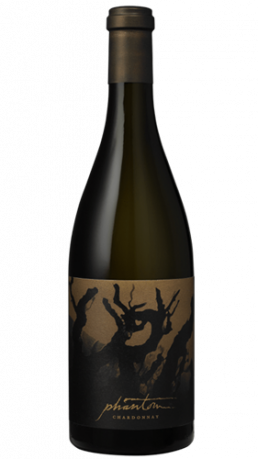
Bogle Phantom Chardonnay 2019
“…entices with its rich layers. Green apple and pear transform into spicy flavors of freshly baked apple pie, while barrel fermentation imparts a creamy, luscious mouthfeel. French oak whispers sweet notes of vanilla and melted caramel.”
92/100 points & Gold Medal awarded – Sunset International Wine Competition 2021
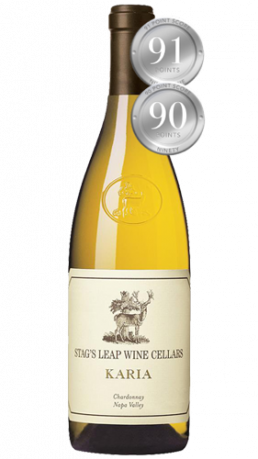
Stag’s Leap Karia Chardonnay 2018
“This is an opulent, structured, and mineral-driven white wine, richly layered and robustly built with weight and ample body. Brioche, honeycomb, and baked apple meet a complement of fresh acidity and a lasting note of stone.”
91/100 points – Wine Enthusiast
“The 2018 Chardonnay Karia comes from a selection from throughout the valley and offers a light gold color as well as a rich, well oaked, buttery style that includes attractive orchard fruits, white flowers, vanilla, and spice-driven aromas and flavors. It has good acidity as well and is balanced and medium-bodied, all making for a certainly delicious Chardonnay geared for near-term drinking.”
90/100 points – Jeb Dunnuck
Cowboy Beans
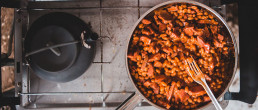
- 4 cans of Pinto beans, (or a mix of Red kidney, Black Beans or White beans – drained of liquid)
- 1 tablespoon bacon fat
- 1 tablespoon vegetable oil
- 1 medium yellow onion, chopped
- 5 cloves garlic, minced
- 1 smoked ham hock
- 2 cups water
- Salt, to taste
- 2 cups brewed coffee
- 1 1/2 cups tomato-based barbecue sauce
- 1/4 cup chopped pickled jalapenos for garnish
- Grated cheddar or similar cheese for garnish, optional
- 1/4 cup chopped red onion for garnish
Heat the bacon fat and the vegetable oil in a Dutch oven or other heavy-bottomed lidded pot over medium-high heat.
Add the onion and sauté for 3 minutes, stirring often, until translucent and just beginning to brown.
Add the garlic and sauté for another 1 to 2 minutes.
Place the drained beans into the pot with the onions. Add the ham hock, the water, a little salt, and the coffee. Stir and bring to a simmer. Cook for about 1 hour. The beans should be soft enough to chew but not mushy soft.
Add the barbecue sauce and stir to combine. Cover and simmer on low heat until the meat from the ham hock begins to separate from the bone.
After an hour, check on the beans every 15 minutes. If the beans begin to break down, remove from heat. When the beans are done cooking, pull out the ham hock and strip the meat from the bone. Add the meat to the beans and discard the bone.
Add salt to taste. Add pickled jalapeños to taste for some heat, if desired. Serve with a little grated cheese and chopped red onion on top.
We’re going from the sublime to the ridiculous in this match up… the very classy super-smooth Duckhorn Three Palms Merlot juxtaposed against the very humble Cowboy Beans dish. But Merlot is a bit of a chameleon and because of this it is an easy match with a wide range of foods. Its dry, natural acidity combined with ripe red fruit flavours and leafy aromas make it an ideal pairing for full flavoured dishes. Not to mention silky tannins and a soft smooth finish make this bad boy combo a taste sensation.
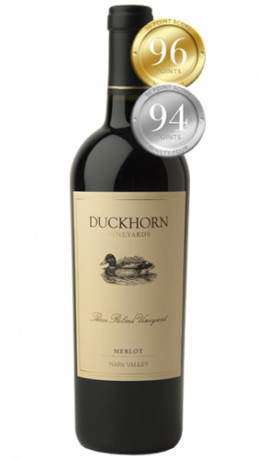
Duckhorn Three Palms Merlot (Napa Valley) 2018
“Elegantly structured and featuring concentrated cherry tart and raspberry pastry flavors that are loaded with toasty richness. Creamy and spice-filled finish is backed by firm acidity and tannins”
94/100 points – Wine Spectator
As a testament to its status as the benchmark for New World Merlot, in 2017, the Wine Spectator honoured the 2014 Three Palms Vineyard Merlot as “Wine of the Year.”
“The Cathedral of Merlots, with imposing structure and a towering presence – a sheer joy to drink. Drinking Window 2021 – 2035”
96/100 points – Decanter
Once again, the famed Three Palms Vineyard has yielded a fascinating and luxuriously full-bodied Merlot. Aromas of huckleberry, black cherry, chocolate, and fig rise from the glass, followed by hints of graphite, graham cracker, bay leaf and sage. On the mouth-watering palate the flavors are intense and complex, with velvety tannins and voluptuous fruit balanced by earthy undertones and Three Palms’ classic minerality, all of which carry the wine to a rich and remarkably long finish. Blend: 89% Merlot, 7% Cabernet Sauvignon, 3% Cabernet Franc, 0.5% Petit Verdot, 0.5% Malbec (Winery notes)
There’s a Secret Ingredient in Cowboy Beans. Its Coffee! Legend has it that back in the day, cowboys added leftover coffee to their pot of beans because fresh water was not so easy to come by—a cowboy version of waste not, want not. Coffee adds a depth of flavour and a slight bitterness that keeps the sweet-spicy of the barbecue sauce in line.
Two-Step Texan Ribs
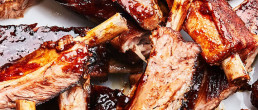
- 1 Tbsp onion powder
- 1 tsp smoked paprika
- 1 tsp ground cumin
- 1 tsp celery salt
- 1/2 tsp black pepper
- 1 Tbsp brown sugar
- 2 Kgs pork baby back ribs
- 1 Cup of your favourite barbecue sauce
Preheat oven to 200 degrees C
In a small bowl, combine paprika, onion powder, cumin, celery salt, pepper, and brown sugar; rub seasoning mixture over ribs. Place each rack of ribs on a large piece of aluminium foil. Wrap foil securely, leaving room for steam to circulate, seal edges tightly. Place foil packets on a baking sheet.
Bake 2 hours, or until meat is fork-tender. Open packets carefully, as steam may be released. Brush ribs with barbecue sauce and place back in oven 15 to 20 minutes, uncovered, or until sauce starts to caramelize.
Zinfandel wine is happiest when paired with anything from the meat aisle, from barbeque pork ribs, leg of lamb or a big, hearty meal. And it loooves spice! Here’s our D&N team favourite:
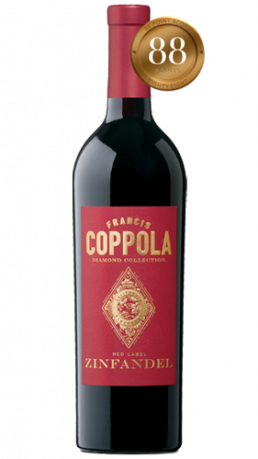
Francis Ford Coppola Diamond Collection Zinfandel 2018
The bouquet reveals lush aromas of freshly picked blackberries, raspberries, and a hint of star anise. The palate is pampered by juicy plums, black cherries and freshly ground white pepper. Sourced from old vines in Amador County and cooler sites in Paso Robles and Sonoma, this wine comprises approx.90% Zinfandel with 10% Petite Sirah and was matured 10 months in French oak. The Petite Sirah further enhances the luscious strawberry jam, cassis and briar flavours that follow its perfume of dark fruit, sweet spice, and toasty vanilla. (Winery notes)
Slow Cooker Beef Brisket
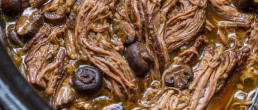
- 3 Tbsp Olive oil to sauté, divided
- 2 kgs beef brisket
- 2 tsp salt and 1 tsp black pepper, or to taste
- 2 medium yellow onions, sliced into thick strips
- 500g mushrooms, thickly sliced (leave some whole if you prefer)
- 6 medium garlic cloves, peeled and chopped (not pressed) *
- 2 cups chicken or beef broth/stock (or for fun an American-style pale ale)
- 2 1/2 Tbsp Worcestershire sauce
Generously season brisket with about 2 tsp salt and 1 tsp black pepper. Heat a large heavy skillet or cast-iron pan over high heat. Add 1 Tbsp olive oil and when hot, add brisket (fat side down). Sear 4-5 minutes per side or until browned on both sides. Transfer to slow cooker with the fat side facing up.
In the same pan, add 1 Tbsp olive oil and sliced onions. Sautee 5-7 minutes or until onions are caramelized. Place onions over brisket. In the same pan, add more oil as needed and sauté mushrooms until softened (5 min). Place mushrooms into the slow cooker. Sprinkle chopped garlic over the mushrooms. Combine 2 cups chicken broth with 2 1/2 Tbsp Worcestershire sauce and pour mixture over the meat.
Cover and cook on low 7 to 8 hours or until cooked through and easy to pull apart with forks. Turn off slow cooker and rest for 15 minutes with the lid on. Remove and discard excess fat from the top then pull the beef apart with forks and keep it in the slow cooker to soak up the juices which will add incredible flavor and keep the meat tender. Serve beef brisket and mushrooms, spooning the slow cooker brisket juices over the top.
***Cheeky trick to use the Beef Brisket as a burger filling – finish it off on the BBQ! When the brisket is tender but before the pull-apart stage, remove from the roasting pan or casserole. Oil the already medium hot BBQ grill. Place beef on the grill and brown on both sides. Baste the beef generously with BBQ Sauce turning and basting both sides. Continue to do this until there is a nice, caramelised glaze on the brisket. You can then serve inside a burger bun with all the fixings & with extra BBQ sauce on the side. Boom! Multi-purpose brisket – yummo!
American Cabernet Sauvignon is a food-world favourite, and it’s easy to see why. Its tannic structure, coupled with its red- and black-fruit flavours compliment hearty dishes perfectly.

Spottswoode Lydenhurst Cabernet Sauvignon 2018
“A wine well worth purchasing and cellaring, the 2018 Cabernet Sauvignon Lyndenhurst sports a dense purple hue as well as classic Cabernet notes of blackcurrants, Asian spices, violets, licorice, and tobacco. Beautifully rich, full-bodied, and concentrated, it’s one heck of a second wine that can be drunk today or cellared for 15-20 years.”
94/100 points – Jeb Dunnuck
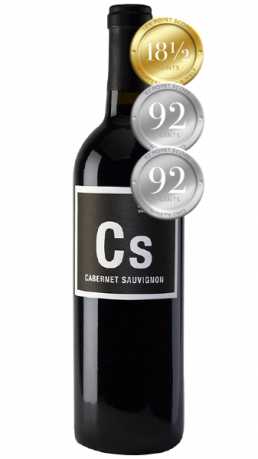
Wines of Substance Cabernet Sauvignon 2019
“Juicy blue fruits, leafy tobacco, violets, and orange blossom notes all emerge from the 2019 Cabernet Sauvignon Cs and it’s medium to full-bodied, has a beautifully balanced, fruit-forward style, no hard edges, and a great finish. It’s no simple fruit bomb and has notable structure, ripe tannins, and outstanding length. It reminds me of a top Cru Bourgeois from Bordeaux and represents a stunning value. Drink it over the coming 7-8 years.”
92/100 points – Jeb Dunnuck
“Currants, flowers, and walnuts on the nose. Medium-bodied with a pretty core of fruit and fine tannins and a crisp finish. Lead pencil. Fresh. Compact. Delicate and delicious. Enjoy.”
92/100 points – James Suckling
Mac-n-Cheese
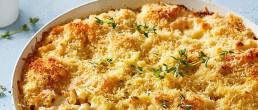
- 125 g Bacon, thick cut pieces rindless
- 2 cups Macaroni (Elbow or any short pasta)
- 50g Butter
- 3 Tbsp Flour
- 3 cups Milk
- ½ cup Cream
- 1 cup any tasty cheese, like gruyere, cheddar, etc. grated, plus 1/2 cup extra for topping
- ½ cup Breadcrumbs, white or panko
Heat the oven to 200C. Lightly grease a medium-sized oven-proof dish.
Lightly pan fry bacon pieces and set aside.
Cook the macaroni elbows in lightly salted boiling water according to the instructions on the packet, or until al dente. Drain and rinse under cold water to arrest the cooking and set aside.
In a medium-sized saucepan, melt the butter over a low heat. Stir in the flour to form a roux. Allow roux to bubble gently, stirring continuously until lightly golden. Remove from the heat, add milk and cream to the roux, and stir or whisk until well combined.
Return to the heat and stir continuously until the sauce is shiny and thick enough to coat the back of the wooden spoon. Remove from the heat, add the grated cheese and bacon lardons.
Stir cooked macaroni elbows through the sauce and season to taste with salt. Spoon into the dish.
Mix together the breadcrumbs and extra grated cheese and sprinkle over the macaroni cheese.
Place in the oven and cook for 15-20 minutes until golden and bubbling.
Actually, here in Godzone now, it’s too darn cold for the American 4th July classic Potato Salad or Coleslaw so we’re subbing in the all-time American fave Mac-n-Cheese. Easy to match with either a chardy or a warming red.
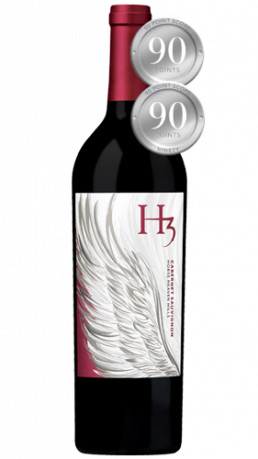
H3 Horse Heaven Hills Cabernet Sauvignon 2019
“Compared with previous vintages, the oak has been pulled way back here. The aromas of blackberry and plum show a bit of reduction. Lightly sweet plum flavors follow. The tannins give a light grip. There’s much enjoyment to be had.”
88/100 points – Wine Enthusiast
Chocolate Brownies with Raspberry ‘Pops’

- 125g unsalted butter, chopped
- 125g good quality Baking Dark Chocolate, chopped
- 3 eggs, lightly whisked
- 335g (1 1/2 cups) white sugar
- 115g (3/4 cup) plain flour
- 30g (1/4 cup) Dutch cocoa powder
- 1 tsp vanilla extract, Pinch of salt
Freeze-dried raspberry ‘crumbs’ as garnish with whipped cream (optional)
Preheat oven to 180C/160C fan forced. Grease a 20cm (base measurement) square cake pan and line with baking paper.
Place butter and chocolate in a heatproof bowl over a saucepan of simmering water (don’t let the bowl touch the water). Stir with a metal spoon until melted. Remove from heat. Quickly stir in egg, sugar, flour, cocoa powder, vanilla, and salt until just combined. Pour into prepared pan. Bake for 30 minutes or until a skewer inserted in the centre comes out with moist crumbs clinging. Set aside to cool completely.
And just because you can… why not top off your Independence Day partaaaay with the belle of the ball:
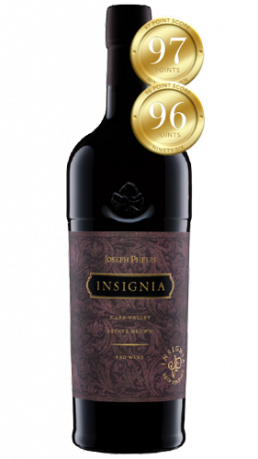
Joseph Phelps “Insignia” Napa Valley Cabernet Sauvignon 2017
“A beautiful, focused wine with a tight center palate of blackberries, blueberries, and dark chocolate. Very subtle. Hints of mint and sage, too. Medium to full body and fine, racy tannins. A reserved and very pretty Insignia. Fresh finish. Hard not to drink now, but better in 2022.”
96/100 points James Suckling
“The 2017 Insignia is beautiful stuff that excels in the vintage. Revealing a dense purple color as well as stunning notes of crème de cassis, lead pencil shavings, tobacco, and earth, it hits the palate with full-bodied richness, a silky, seamless texture, building tannins, and a great finish. It has the more linear, elegant style of the vintage, yet it’s balanced, has ample concentration, and is just a gorgeous wine that will evolve for 30 years or more.”
96/100 points – Jeb Dunnuck
COMING SOON!!!! The 2018 “Insignia”- 99 pts James Suckling; 98 pts Jeb Dunnuck; 97 pts Robert Parker’s Wine Advocate
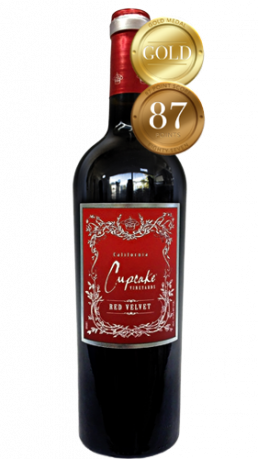
Finally, sweets time. It may seem counter-intuitive, but silky, velvety, and fruiti-licious wines can be chocolate’s best friend. And we love this combo of a rich red fruit forward blend with gooey dark chocolate brownies sprinkled with raspberries. Hmmmm!
Cupcake Red Velvet NV
A delightful blend of Zinfandel, Merlot, and Petite Sirah, sourced from the finest vineyards in California. “A very approachable style; the fragrant bouquet shows strawberry jam, raspberry, vanilla, cocoa, and cedar characters, leading to a supple palate that is fruity and smooth. The medium-full-bodied red is easy going with tasty flavours, finishing friendly and silky”
89 points – Sam Kim, Wine Orbit
HAPPY 4th JULY!
Focus On: Chardonnay - The American Dream
Focus On: Chardonnay - The American Dream
It’s as American as Mom’s apple pie.
Chardonnay is the wine people seem to love to hate. And yet, Chardonnay is still the most popular grape variety in the United States, and the most widely planted white wine grape around the world. It seems, for as much as Chardonnay may have its haters, hey, we’re talking about you guys – the “ABC” (Anything But Chardonnay) club – this world-famous grape is definitely having a major moment!
Globally Chardonnay has achieved a level of branding unlike any other wine. Surprisingly, though, what you get when you buy Chardonnay can differ greatly from country to country and even within one country as is the case in the vastness of the US. So much depends on many factors – such as on the microclimate where it’s grown, the terroir, when it’s picked, how it is vinified and aged, and more!
The diversity is apparent where in the cool climate regions Chardonnay tends to be fresh, crisp and minerally with apple, stone fruit, and lemon notes compared to the warm climate characters of rich and buttery with tropical fruit overtones. Chardonnay definitely runs the gamut.
Luckily for us at Dhall & Nash, we are spoilt for riches when it comes to a variety of super sexy American Chardonnays. We have hung our hat on this from our early days of importing the luscious and ever-popular Coppola and Bogle wines. Now it is time to Focus On a few other ample beauties from our American collection.
Whether oaked or unoaked, Chardonnay is a white wine that is just as perfect on a beach in the summer as it is relaxing by the fire in the winter. Yet as much as we love or hate Chard, there’s still a lot that many of us don’t know about it which is really doing a disservice to this noble grape variety. Time now to see how American Chardonnays have come of age.
A 'Dolly Parton', An 'Audrey Hepburn' or an 'Angelina Jolie' – Take Your Pick!
Perhaps no other wine has such a flavour-forward reputation than American Chardonnay. It is often many wine drinkers’ first experience with a white American wine, and that experience was once typically punctuated by a mouthful of oaky flavour. Not gentle, dulcet tones of oak, but so much oak that one might find themselves inspecting their glass for wood splinters. Just jokin’! But it was true some of those early styles of white wines coming out of California were just too much oak for many of us.
Remember the context though – that was the bold and blaring ‘80s – big hair, big shoulder pads, big overblown oaky chardys drunk during big, long business lunches. Times have changed… Palates have evolved. What you liked a few years ago may be different than what you like today. Tastes change!
We have come to realise that that type of “butter bomb” Chardonnay is not always good with food either; too heavy, too cloying. However, with winemakers leading the charge and with consumers following, there has been a realisation that we wanted more acidity in the wines and more balance. But then defining balance (fruit, tannin, acidity, alcohol, structure, complexity) is somewhat akin to defining beauty – darn difficult and exceedingly elusive!
“Balance [in wine] exists, to some extent, in the eyes of the beholder.” – Rajat Parr (Acclaimed Sommelier & Co-Founder of In Pursuit Of Balance – wine movement)
To Oak or Not to Oak… Too Much of a Good Thing?
Firstly, Chardonnay is an aromatically neutral grape. Flavour-wise, Chardonnay is the ‘chicken’ (or ‘tofu’ for some folks) of the wine world. It is a blank canvas that winemakers are free to paint on. To oak, semi-oak or not to oak at all, to allow partial or full malolactic fermentation, or to add richness and texture by lees stirring – these are some of the factors a winemaker has to consider in choosing whether to create an angular ‘Angelina’ Chablis style of high acidity, no oak and minerality, or a voluptuous ‘Dolly Parton’ full-blown, buttery vanilla, richer style, or something understated and elegant in-between, an ‘Audrey’.
A disclaimer here though – quality is actually independent of style! Any Chardonnay, oaked or not, can be either awesome or poor. Yet it is the oaked style that tends to spark controversy mainly because some American winemakers haven’t always applied oak with a moderate hand.
“A kiss of oak is nice, but too much is the kiss of death.” – (Anonymous winemaker)
When oak is out of balance in Chardonnay, it sticks out in the form of toasty, sweet, caramelized aromas, and flavours, often with a strong hint of rich vanilla bean and coconut or even Bourbon! (if American oak barrels are used.)
There’s nothing wrong with those characteristics, of course, but all in moderation. How can a wine that sees a lot of new French or American oak maintain such balance? Experts believe it’s all about the vineyard and the intensity of the fruit it yields. Most vineyards simply don’t produce sturdy enough fruit to support a lot of new oak. Some more established vineyards have fruit with enough structure, natural acidity and hang time to support a certain level of oak. In other words, the more intense the fruit and the higher the acid levels, the more oak the wine can shoulder.
And guess what? “Buttery” Chardonnay has nothing to do with oak and everything to do with Malolactic Fermentation (MLF). That’s a process where Malic acid (think tart green apples) converts to Lactic acid (think rich creamy texture). If the winemaker allows this fermentation to occur – which happens after all the sugars have been converted to alcohol – you get a more “buttery”, creamy, and rounded texture. If they don’t, the wine is tarter and crisper. And of course, the winemakers can do varying percentages of MLF (called Partial MLF) dependent upon their fruit quality and style they wish to craft.
James Eyer, general manager at the renown Chardonnay specialist winery, Hyde de Villaine, said:
“As the wine culture of the USA and the world continues to grow, wine of elegance and distinction will become highly coveted … and consumers that believed they disliked chardonnay will be reintroduced to what I believe is the true expression of the varietal.”
Allow Us to Reintroduce You to American Chardonnay – Turning Down the Volume:
One aspect of the American wine scene we admire is its wonderful flexibility, and now, after a generation of big, oaky Chardonnay, there’s a quiet revolution going on as winemakers’, and consumers’, tastes evolve. All thanks to a gentle nudge from the now-defunct IPOB ‘In Pursuit of Balance’ movement started by internationally revered Sommelier Rajat Parr and winemaker Jasmine Hirsch. It was a catalyst for dialogue about minimal intervention, restraint, and elegance in wines.
Don’t get us wrong – we still looove those well-crafted rich Napa chardys, but at least for those of us who also like Chardonnay that emphasises elegance with a bit of grip and angularity, this is a timely rejuvenation.
No longer content with the turbo-charged chardys of the past, this American stylistic sea change is being driven by a generation of winemakers seeking to create wines that express every nuance of their terroir. These winemakers are ready to ‘turn the volume down’. They have started with the two most vital elements: clonal selection and site selection.
Without a doubt, both of these are of great importance when it comes to top-quality Chardonnay: lower-yielding clones, with small clusters grown in unique cooler climate areas. In California, the two most suitable clones were the heritage ones: Wente and Calera. For the conditions these have a high skin to juice ratio. For Oregon it was the French Dijon clones that worked their magic.
Guillaume Boudet, winemaker at the prestigious Hyde de Villaine winery, emphasized the importance of “selections naturally producing lower yields, small clusters and small berries, enhancing the true characteristics of the varietal and the site.”
In addition to pursuing vineyards closer to the coast and improving grape growing practices, vintners have undertaken a range of winemaking innovations. One of the key changes has been to move away from warmer extractions during fermentation to cooler and gentler techniques, allowing the characteristics of each vineyard site to shine more clearly in the wines. With this ever-increasing emphasis on viticultural and winemaking details, Chardonnays from cooler climate American sites have a role to play in continuing the region’s outstanding reputation and with inspiring a smidgeon of global influence too.
To help convert even the most ardent Chardonnay sceptics, we’ve pulled together a list of our Dhall & Nash faves from each of the West Coast regions.
Regionality - The West Coast Vibe:
American West Coast producers, from Columbia Valley in Washington State to the Willamette Valley in Oregon to Sonoma counties in California, are rethinking American Chardonnay. They may not be traditionally known for the grape when compared to the famous winemakers in Napa Valley who defined the now stereotypical buttery, oaky style for the white wine. But they are planting, producing, and experimenting with the wine – with a twist. They are skipping the big oak for a more restrained, Burgundian-inspired approach that values balance, freshness, and high acidity for a mineral-driven wine. This is more reflective of their terroirs. They aren’t trying to make a white Burgundy, but they are applying that French philosophy to the vineyard, winery, and cellar. The results are lighter-bodied wine that features tasting notes most wine drinkers wouldn’t necessarily associate with Chardonnay – oyster shell, Nashi pear, green citrus, flint, mineral – and it’s drawing in new consumers who claim to not drink the dreaded Chardonnay!
Washington State:
Even with all the rainfall on the western seaboard of Washington state, it produces stunningly good Chardonnays. How? The Cascade Mountains cause the primary difference. This massive mountain range runs north-south through the state blocking the cool air and precipitation that head east from the Pacific. Here in the ever-warm Columbia Valley, is where the vast majority of the state’s wine grapes are grown. This region provides lush, ripe fruit flavours, while cool nights preserve natural acidity. This yields wines often fuller in style than their peers from Burgundy, but lighter and graced with more acidity than many offerings from California. As always with Washington, the wines can also provide incredible value!
Columbia Crest:
A Washington winery in the Horse Heaven Hills AVA within the Columbia Valley. Founded in 1983, Columbia Crest has grown from a small winery in a relatively unknown wine region to one of the most significant wineries in the U.S. and a major force behind Washington state’s emergence as a world-class wine region. Over the years, the winery has remained committed to the delivery of handcrafted, small-lot wines, as well as affordable, superior quality everyday wines.
2019 Columbia Crest Grand Estates Chardonnay – “Sensationally Slurpable”
Opens with intense aromas of apples and melons, joined by signature characters of crème brulee, caramelized sugar and butterscotch. Ripe orchard fruit flavours are joined by creamy, buttery notes and balanced by lively acidity.
Oak regime: 78% fermented in French and American oak barrels. Matures for 9 months on the fine yeast. The remaining 22% is fermented and expanded in stainless steel tanks.
“Silky and seductive, with pear and spicy grapefruit flavours on a taut, polished frame, lingering with intensity and brightness on the glowing finish. Impressive for the price. Drink now.” 90/100 points, Wine Spectator
Oregon:
Sandwiched between California and Washington, Oregon’s classy efforts could be overlooked. Yet, as a much-lauded producer of world-class Pinot Noir, why couldn’t Burgundy’s iconic white wine grape also thrive in Oregon? In fact, it does.
Initially however, Chardonnay in Oregon got off to a less-than-impressive start. California-sourced Wente clones were widely planted, producing a thick, dull, early-ripening style of wine. But the state’s Chardonnays took a great leap forward in the 1990s, as a few winemaking pioneers began replacing Wente clones with Burgundian Dijon clones.
The similar Burgundian climate of the Willamette Valley has proven to be particularly suited to these new clones, and the resulting Chardonnays have a stunning energy. It is this intensity with subtlety of Oregon’s best Chardonnay versions that differentiate them from the crowded West Coast competition.
In Oregon, the grape’s inherent transparency and elegance punches up the aromatics, bringing nuances of soil and site, herb, and earth, along with crisp citrus fruit. Some winemakers try to enhance these qualities with all-stainless, concrete egg and clay amphorae-fermented wines, which prove that barrel ageing is only an option, not a requirement, for complexity.
Cristom Vineyards:
2018 marked the inaugural release of Cristom Vineyards’ Eola-Amity Hills Chardonnay, featuring fruit from their own estate Louise and Paul Gerrie vineyards, as well as five other neighbouring sites in the Eola-Amity Hills AVA. Though they are no strangers to Chardonnay, having produced the varietal since their founding in 1992, this new release marks the expansion of Cristom’s Chardonnay programme, both through collaborating with extraordinary neighbouring winegrowers, as well as the expansion of Chardonnay plantings on the Cristom Estate.
2018 Cristom Eola-Amity Hills Chardonnay – “Purity & Precision”
Rated “One of the Year’s Best Chardonnays of 2020” by Wine & Spirits Magazine.
Oak regimen: Aged in 31% New French oak barriques for 12 months. 13% alc.
“Restrained and delicate, this cool Chardonnay leads with dry lemon-lime scents. With its tart green-apple flavour, lemon-rind lift and talc-like mineral tang, it’s a Chablis-like Chardonnay for oysters.” 91/100 points, Wine & Spirits
“The 2018 Chardonnay Eola-Amity Hills, aged 12 months in 31% new French oak, offers fresh orchard fruits with touches of almonds, white flowers, and baker’s yeast. The palate is light-bodied but surprising with its depth of fruit, with soft freshness and a long, delicate finish.” 91/100 points, Robert Parker’s Wine Advocate
California:
This is the state that invented Big, Bold, and Beautiful! More than 80% of the wine made in the USA is made in California, making it the fourth largest producer of wine in the world (behind Italy, France and Spain). California wine regions run the length of the state and have 139 American Viticultural Areas or AVAs. Each American Viticulture Area has a distinct “persona” that divides it from the other AVAs. The distinct “persona” is mainly categorized by climate, geology, and elevation. No surprise, Napa Valley was the original California AVA.
“California Chardonnay has swung from lush to skinny and back again in the past two decades, and finally the pendulum has come to rest.” – Elaine Chukan Brown
It has definitely been on a rollercoaster ride of changing styles and tastes. But more recently, winemakers have begun to find a happy middle ground, balancing mouth-watering flavour with respect for what the vineyard gives them.
Sonoma Coast AVA:
Sometimes called “Burgundy on the Pacific”. The two famed grapes of France’s esteemed Burgundy area – Pinot Noir and Chardonnay – have both found a new home in this part of California.
Flowers Vineyards & Winery:
The pioneers of the Sonoma Coast. When others said it couldn’t be done, in 1989, Joan and Walt Flowers were among the first to plant grapes on the first ridgeline off the Sonoma Coast. The extreme Sonoma Coast is a place of unique character with the Pacific Ocean less than two miles from the vineyards, generating cooling sea breezes and coastal fog, while the soaring elevations range from 1,150 to 1,450 feet positioning the vineyard above the coastal fog layer, thus allowing generous amounts of sunshine during the growing season. This unique combination of abundant sunshine and cooling fog rolling in and out of the vineyard creates an idyllic growing environment for elegant and nuanced Chardonnay showing bright fruit focus, complex minerality and crystalline acidity.
2018 Flowers Sonoma Coast Chardonnay – “Masterful Elegance”
100% native yeast.
Oak regimen: Aged for 3 months on lees in stainless steel tanks. 100% French Oak (18% new) for 11 months.
“This classy 2018 has notes of musky pineapple, crushed citrus, and white flowers as well as a kiss of salty minerality. It has bright acidity, beautiful balance, and is just a classic, elegant Sonoma Coast Chardonnay that does everything right.” 93/100 points, Jeb Dunnuck
Russian River Valley AVA:
Also within Sonoma County, this is a highly regarded growing region for Chardonnay. Characterized by its cool climate and coastal fog that travels in from the Pacific along the Russian River, the Russian River Valley’s climate allows for a slow ripening of the grapes, resulting in wines of balanced acidity and complexity.
Kosta Browne:
Once again, we see the marine influence that follows the Russian River inland from the Pacific coast is a powerful attribute of this region. This is from the coolest parts of the Russian River Valley. Here, fruit is allowed to mature gracefully on the vine, which offers more intensely focused flavours and generous natural acidity.
Kosta Browne was informally founded by Dan Kosta and Michael Browne when the two pooled their tip money from restaurant work and bought some Pinot Noir grapes in 1997. The company has now become a bit of a cult winery commanding premium prices for their primo wines
This vintage Kosta Brown winemaker Julien Howsepian continued his pursuit in delivering exceedingly fresh and precise wines by incorporating traditional, and non-traditional French oak foudres into their Chardonnay winemaking. These larger vessels seamlessly weave complexity and purity into one, integrating the gross lees and the wine with slower and patient micro-oxygenation due to thicker oak staves and less wood to wine contact ratio.
Winemaker Howsepian describes the Chardonnays as “energetic in spirit but rich in body”.
2017 Kosta Brown ‘One Sixteen’ Russian River Valley Chardonnay – “Statuesque & Stylish”
Oak & ageing regimen: 34% New French Oak for 15 months / 30% Stainless Steel tank for 4 months / 18% Foudre for 9 months / 1% Concrete tank for 15 months / 2% Concrete egg for 14 months.
“A beautiful Chardonnay … brought up in 34% new French oak, the 2017 Chardonnay One Sixteen Russian River Valley sports a medium gold colour as well as a rich, powerful bouquet of caramelized citrus, white currants, toasted hazelnuts, and brioche. Deep, rich, medium to full-bodied, and beautifully textured, it has flawless balance, bright acidity, and is a profound Chardonnay that will stand beside the finest white Burgundies.” 97/100 points, Jeb Dunnuck
Napa Valley:
No other wine region on the planet draws as much attention as Napa Valley. Its incomparable beauty couples seamlessly with generations of passionate winemakers behind some of the world’s truly exquisite wines. Here the combination of Mediterranean climate, geography and geology of the region are conducive to growing top-quality wine grapes. It is Napa’s great diversity, both in terms of climate and terroir, that has led to the creation of 16 smaller AVAs like Stags Leap District, Rutherford, Howell Mountain, Oakville, and Mount Veeder, among others. Here Cabernet and Chardonnay still reign supreme.
Stag’s Leap Wine Cellars:
Stag’s Leap Wine Cellars, notably known for being the winery that won the Cabernet Sauvignon competition in the famous 1976 Judgment of Paris, was founded in 1970, and is considered a Napa Valley first-growth estate. They create wines of classic beauty – wines with balance, complexity, and harmony. Their signature style has often been described as “an iron fist in a velvet glove”, a reference to the artful balance between ripeness and restraint, softness, and structure, that yields Napa Valley wines of exceptional beauty and long life.
With a tradition of mentoring that dates back to our founding in 1970, Stag’s Leap Wine Cellars has been a springboard for many a celebrated winemaker’s career. This Chardonnay is a tribute to the alumni whose vision of crafting elegant and balanced wines has been passed down from teacher to student, and “through the hands of time”.
2018 Stag’s Leap Hands of Time Chardonnay – “Generous & Vivacious”
Ageing regimen: 6 months on lees, stirred every 2 weeks, 91% previously filled French oak barrels (9% new).
“This is an opulent, structured and mineral-driven white wine, richly layered and robustly built with weight and ample body. Brioche, honeycomb, and baked apple meet a complement of fresh acidity and a lasting note of stone.” 91/100 points, Wine Enthusiast
Duckhorn Vineyards:
Duckhorn has been making wine using grapes from the finest Napa Valley vineyards for over 40 years. Building on this rich history, their Napa Valley Chardonnay comes from the coolest regions. In the cellar, they have applied classic techniques of French oak barrel fermentation with lees stirring, resulting in a Chardonnay that balances the complexity and richness of Napa Valley.
2018 Duckhorn Vineyards Napa Valley Chardonnay – “Opulent & Unapologetic”
40% malolactic fermentation.
Oak & ageing regimen: 10 months in French oak; 40% new oak, 30% 2nd vintage, 30% neutral.
“A full-bodied, creamy white, showing lots of ripe fruit on the nose with peach pie, baked apple, and mango, followed by hazelnut and custard pastry on the palate. Crisp acidity.” 93/100 points, James Suckling
“With grapes from such stellar sites as Hudson, Trefethen, Antinori and Stanley Ranch, this white is lush, seamless, and sound across the board. It is approachable and fleshy in apple, pear, and mango tones, accented by toasted oak and vanilla.” 90/100 points, Wine Enthusiast
Unlike the spiritual homeland of Chardonnay, Burgundy, the beauty of American Chardonnay is that there are no rules. Well, there are very few regulations let’s say, a wide range of terroirs and the local vintners are willing to explore all the stylistic possibilities appropriate to their land while keeping a close eye on the market.
As we know, in the end, it’s all a matter of taste. Consumers will decide for themselves the style of Chardonnay they like, unoaked, heavily oaked, or something heavenly in between. So, raise a glass to the resilience, creativity, and passion of America’s winemakers and enjoy this bounty of luxuriously luscious Chardonnays!
Spottswoode: The 100-Pointer Immensely Collectible California Cabernets
Spottswoode: The 100-Pointer Immensely Collectible California Cabernets
"If Château Margaux were in Napa Valley, it would Spottswoode." - Robert Parker
Spottswoode has often been compared to Château Margaux, the great first-growth Bordeaux known for its refinement relative to the brawnier first-growths of Pauillac.
There’s a reason why Robert Parker called Spottswoode the ‘First-Growth’ of Napa Valley. Their Estate Cabernet, which is predominately Cabernet Sauvignon with a small percentage of Cabernet Franc and Petit Verdot, drinks as well as many of the famous Left Bank First-Growth Bordeaux and, remarkably, at a fraction of the price!
Not to mention… but do go on! Renowned wine critic James Suckling has described the 2018 vintage as “one of the best years in the past two decades” in Napa Valley. So, what are you waiting for?!
Along with the legendary Estate Cabernet, Spottswoode also makes a ‘baby brother’ label named Lyndenhurst after the historic property that originally stood where Spottswoode is now. This wine is made to be enjoyed upon release and drinks fresh, with ripe fruit and a luscious mouth-feel. If the Estate Cabernet is Margaux, then the Lyndenhurst is Haut-Medoc.
Be warned though… the Spottswoode wines are a hit year after year and always sell out. These are going to be no different. Fortunately for all you ardent Californian Cab fans, Dhall & Nash has the current vintages of 2017 and 2018 arriving SOON to our shores! And in large format bottles, too! The time is perfectly ‘ripe’ to buy now to assure you won’t miss out on these ICONIC wines!
You can read more about Spottswoode’s story in another blog post we’ve done by clicking here.
A Brief Background:
Although the vineyard was first planted in 1882, Spottswoode’s “modern” era began in 1972, when Jack and Mary Novak acquired the historic Spottswoode Estate. In the years since, two generations of the Novak family have stewarded the vineyard and made it a proving ground for environmentally responsible winegrowing and winemaking. The legacy of legendary matriarch Mary Novak has now been taken up by the second generation, her daughters, Beth Novak Milliken and Lindy Novak with viticulture and winemaking curated by Aron Weinkauf.
In 1985, Spottswoode became one of the first wineries in Napa Valley to farm its estate vineyards organically – and it has been untouched by chemicals ever since. Today, Spottswoode is certified organic and biodynamic, and is solar powered.
Its terroir, being of alluvial, clay loam soil is one of Spottswoode’s greatest assets. Along with its incredibly special position at the bottom of the Mayacamas Range where it meets Spring Mountain, thus creating a gap in the hills which regularly allows in the cooling Pacific ocean influence. This provides the essential diurnal shift to enhance freshness and flavour profiles. Without doubt the Spottswoode vintners craft elegant, balanced and age-worthy Cabernets that capture the character and the complexity of the legendary estate vineyard sites. Whilst each vintage is a snapshot in time, the annual cycle of farming is built upon the viticultural wisdom acquired over many decades.
As wine writer Jancis Robinson MW writes, “In the Napa Valley Cabernet arena, where muscle and potency seem to have become the most admired, or certainly the most notable attributes, it is unusual to read a producer claiming, ‘we strive for refinement, elegance, and balance’.” However, that old idea that all Californian Cabernet is over-ripe, high alcohol, and lacking in complexity is just that – an old idea. These are seasoned vintners who truly know their land, who weather earthquakes, wildfires, and multiple years of drought, so, when Mother Nature gives them half a chance, Spottswoode’s winemakers craft exquisitely expressive Cabernets of great structure and soaring beauty.
As James Molesworth so aptly wrote in the Wine Spectator: “There’s a delicacy to the Spottswoode Cabernet, but the wine is no pushover. Sneaky long and with tensile strength, it’s a yoga pose held for minutes, in stark contrast with the stereotypical Napa Cab’s bodybuilder reps. It has a uniquely pure feel, and while it’s in a less “obvious” style, its ageability is clear. The wine, like the estate, has the reach to connect Napa’s past to its future.”
Dhall & Nash is honoured to announce the upcoming release of the iconic wines of Spottswoode:
2017 Spottswoode Estate Cabernet Sauvignon:
This wine has been widely hailed as a classic and is one of those wines that is perfectly balanced and divinely delicious already, yet has another several decades of life left in it.
Wine Notes: Aromas of sage, forest floor, currants, blueberries, pencil shavings, and violets are lifted and utterly beautiful, and the palate is pure perfection. Balanced and concentrated with currants, blueberries, black raspberries and gobs of mixed cherries, sandalwood, incense (especially on the finish), cedar, orange oil, and dark chocolate.
Vintage Report 2017: It wasn’t an easy vintage by any stretch – and not just because of the fires that year. After Labour Day, Spottswoode experienced 10 days of extreme heat over 37 degrees Celsius. Harvest “felt more like triage”, noted winemaker Aron Weinkauf. Fortunately, the chemical-free farming, and biodynamic techniques seems to have built in some hardiness and some integrity into the land. CEO Beth Novak-Miliken added that, “there’s just a resilience in the vineyard that allows it to weather these extremes” which seems like it will be a defining factor in any top vineyard’s greatness moving forward, as extreme weather and climate shifts continue to impact the growth and rhythms of the vineyard and grapes.
2018 Spottswoode Estate Cabernet Sauvignon:
Wine Notes: A wine of beauty and bounty. Notes of black cherry, bergamot, red raspberry, and plum encapsulate a sturdy core of powdery tannins and vibrant acidity. Hints of rose and citrus blossom permeate its youthful and primary aromas. This is a wine of great freshness, elegance, and power that will generously reward for years to come.
Vintage Report 2018: The late Spring rains provided much-needed soil moisture at the time of bloom and fruit set, and coupled with healthy primordial buds, led to a textbook crop set. Overall, it was a long, slow growing season. Though there were some hot days, summer generally brought foggy mornings followed by sunny afternoons and chilly nights. These ideal growing conditions extended the ripening season and Spottswoode started picking reds near the end of September. Fruit was in excellent condition at harvest, with lots of colour and balanced sugars. The resulting wine is aromatic and vibrant, filled with great promise.
2018 Spottswoode Lyndenhurst Cabernet Sauvignon:
Wine Notes: A complex and inviting Napa Valley Cabernet Sauvignon suggesting notes of raw fresh blackberries, crushed graphite, cassis, baking spices, and cocoa powder. Fine tannins provide savory structure, while floral notes of violets and laurel perfume the glass.
Part of Spottswoode’s storied history inspired the name Lyndenhurst, a tribute to the fragrant linden trees that still bloom in the gardens today. Lyndenhurst Cabernet Sauvignon is a dynamic and inviting wine made from grapes grown in the Estate Vineyard blended
with those from other acclaimed family-owned vineyards.
Recent Accolades:
These are wines of great classicism and quality with enormous ageing potential, as the following accolades affirm.
2018 Spottswoode Estate Cabernet Sauvignon:
“Composed of 86% Cabernet Sauvignon, 9% Cabernet Franc and 5% Petit Verdot, the 2018 Cabernet Sauvignon from Spottswoode explodes from the glass with bombastic notes of crushed blackcurrants, fresh blackberries, and wild blueberries with hints of cardamom, lilacs, incense, and fragrant earth, leading into wafts of pencil shavings and crushed rocks. Medium-bodied, elegant, and yet so, so intense, it has layers of bright crunchy fruit and mineral sparks galore, framed by exquisitely ripe, finely pixelated tannins, finishing very long and energetic. Wowsers!” 100 points – Lisa Perrotti-Brown, The Wine Advocate (05/11/2020)
“One of the wines of the vintage, as well as a legendary Napa Cabernet that will compete with anything out there, the 2018 Cabernet Sauvignon Estate reveals a deep purple hue as well as extraordinary notes of pure crème de cassis and blackberry-scented fruits intermixed with lots of tobacco leaf, lead pencil, spice, and hints of flowers. Reminding me of the 2016 with its purity as well as its balance, it hits the palate with full-bodied richness, a layered, seamless texture, and a blockbuster of a finish. This is a wine you don’t want to miss! It’s going to take 7-8 years to hit its early drinking plateau and cruise for 30-40 years in cold cellars.” 100 points – Jeb Dunnuck (28/01/2021)
“The 2018 Cabernet Sauvignon soars out of the glass with stunning intensity. A powerful, regal wine, the 2018 possesses off-the-charts richness and layers of flavour that build into a dizzying crescendo of aromas, flavours and textures. Bittersweet chocolate, mocha, spice and liquorice accents are laced into a core of dark red cherry and plum fruit. The 2018 is a magical wine. That’s all there is to it.” 99 points – Antonio Galloni, Vinous (04/03/2021)
2018 Spottswoode Lyndenhurst Cabernet Sauvignon:
Suffice it to say Spottswoode’s second label would make the first team at most other wineries.
“The deep purple-black coloured 2018 Cabernet Sauvignon Lyndenhurst comes bounding out of the glass with exuberant scents of fresh blackcurrants, black raspberries and Morello cherries plus hints of lavender, pencil lead and bouquet garni with a touch of Sichuan pepper. Medium to full-bodied, the palate is charged with electric energy, framed by grainy tannins and bold freshness, finishing with great intensity and purity.” 92 points – Lisa Perrotti-Brown, The Wine Advocate (05/11/2020)
“A wine well worth purchasing and cellaring, the 2018 Cabernet Sauvignon Lyndenhurst sports a dense purple hue as well as classic Cabernet notes of blackcurrants, Asian spices, violets, liquorice, and tobacco. Beautifully rich, full-bodied, and concentrated, it’s one heck of a second wine that can be drunk today or cellared for 15-20 years.” 94 points – Jeb Dunnuck (28/01/2021)
“The 2018 Cabernet Sauvignon ‘Lyndenhurst’ is a fabulous wine that shows just how compelling the vintage is, even among mid-tier offerings. Blackberry, graphite, cloves, liquorice, and lavender all build in the glass. The Lyndenhurst Cabernet is usually much more approachable, but the 2018 is a real powerhouse. I would give the tannins at least a few years to soften. This is impressive, to say the least.” 94 points – Antonio Galloni, Vinous (04/03/2021)
The virtuoso wines of Spottswoode, are masterfully wrought and deeply tied to their place of origin. They age gracefully and are crafted in a style that’s consistent with the guiding principles of a fine ‘first-growth’ estate while also leaving room for the natural variations of vintage. Paradoxically, they manage to show poise and gentility alongside majestic energy and vivid concentration. The Spottswoode wines are a must-buy for any serious wine collector and connoisseur.
“Throughout the years, we have stayed true to an elegant and age-worthy style that captures the character of the vintage and the complexity of the vineyard. Our Estate Cabernet Sauvignon is a wine of place. It is the essence of our vineyard in a given vintage.” – Beth Novak Miliken (2nd generation owner/CEO)
Pre-Sale Pre-Cellared Dominus Estate
Year in and year out, Dominus receives well-deserved high praise and high points! Critics and aficionados alike have been blown away by these wines. Fortunately for us, Dhall & Nash has just received a limited allocation of the stunning Dominus Estate and Napanook 2006, 2008 and 2009 vintages all cellared to optimal conditions and ready for your drinking pleasure now!
Napa Valley is often seen as a hotbed of some of the world’s most bombastic and powerful wines. The ‘big name’ producers reign, all together contributing to growing prestige of American wines and their extraordinary global recognition.
Yet, one stands apart from the others. Perhaps because the blending of the traditional winemaking techniques of Old World Bordeaux with Napa’s unparalleled terroir created the ultimate New World Expression – that of Dominus Estate. Since his inaugural 1983 vintage, French owner Christian Moueix has produced, year after year, wines of great purity and balance, achieving his aim for the estate to become “the Haut-Brion of Napa.”
Every great wine has a great story: that story often begins with the man (or woman) behind the wine. In this case it was Christian Moueix who was lucky enough to be born into a famous Bordeaux wine family known for the ownership and management of Châteaux Pétrus, Lafleur, Trotanoy, Magdelaine and several other estates. However, Christian Moueix, even though being raised around wine, didn’t fall in love with it until tasting what the potentially great Napa Valley terroir could produce. This was during his studies of viticulture and oenology at the University of California at Davis in 1968. After finishing his wine studies in 1970, Moueix returned to Bordeaux to manage his family’s Bordeaux estates, yet the young winemaker never quite forgot the Californian terroir that had so inspired him.
As a self-described “terroir freak” he had quickly recognized the potential of the Napa Valley. The moment Christian saw the Cabernet Sauvignon vineyards that are now Dominus Estate, he knew he found the perfect property for high quality Napa Valley Cabernet Sauvignon. The historic Napanook vineyard, a site west of Yountville that had been the source of fruit for some of the finest Napa Valley wines of the 1940s and 1950s. By 1982, Moueix entered into a partnership to develop the vineyard with the daughters of John Daniel (former owner of Inglenook). The forward-thinking Frenchman was on his way with their first vintage being produced in 1983.
In the formative years for Dominus, Jean Claude Berrouet, the winemaker for Chateau Petrus and also for most of the Moueix family owned and managed estates in Bordeaux was instrumental in guiding the production of Dominus. By 1995, Moueix bought the estate in its entirety, naming it “Dominus” (Latin for ‘Lord of the Estate’) to underscore his longstanding commitment to stewardship of the land.
“I can’t think of anyone other than Christian Moueix who could claim to produce one of the greatest wines in France and one of the best in the U.S.” – Robert Parker, Wine Critic
The Napanook Terroir of Dominus Estate:
The Napanook vineyard is located in the volcanic foothills of the Mayacamas mountain range stretching over 124-acres of land consisting of 3 unique soil types: gravel based volcanic soil, clay, and loam on a rolling terroir. That blend of terroir is a large part of what gives the wines of Dominus Estate their unique, elegant, refined style. The Dominus vineyards are planted with a blend of 80% Cabernet Sauvignon, 10% Cabernet Franc, 5% Merlot and 5% Petit Verdot. The vines of the Dominus Estate, some of which are over 100 years old, enjoy a temperate climate, with warm and dry summers moderated by cool breezes from the San Pablo Bay and cold, wet winters.
Many of the practices employed at the prestigious Moueix properties in Bordeaux are in use at Dominus Estate as well. At Dominus, a deep root system is encouraged through dry farming, which forces the vines to dig deep into the soil for natural water sources and results in a better expression of terroir in the finished wines. According to Moueix, dry farming is also the solution to lowering the high alcohol levels typically observed in Napa Valley wines. This method allows the grapes to find their natural equilibrium and ripen enough to be picked much earlier than is typical in the region. Finally, dry farming is also a sustainable practice with environmental benefits, as it conserves water, a precious resource indeed in California.
Out in the historical Napanook Vineyard, Moueix’s combination of dry farming, cane pruning, crop thinning and planting of cover crops throughout the property yields a limited quantity of high-quality, concentrated fruit. They are hand-picked. The fruit is transported to the winery in small harvest baskets, in order not to harm the clusters. All up a gentle viticultural approach.
“We never look for a fruit bomb. I hate the idea of a fruit bomb.” – Christian Moueix, Owner/Winemaker
Winemaking at Dominus - Balance Through Minimal Intervention:
Dominus Estate winemaking is inspired by the tradition of classic Bordeaux wines. Moueix adapted his French technical approach to the California climate and terroir, giving the vineyard maximum attention and applying dry farming measures to produce Cabernet Sauvignon, Cabernet Franc, and Petit Verdot grapes of the finest quality to be used in his minimalistic approach to winemaking.
The Dominus Estate produces two wines, in the style of a Bordeaux chateau: its eponymous First Wine and the more youthful, exuberant, and approachable Napanook. Through both wines, Moueix aims to convey the genuine character of the fruit and the subtle intricacies of the Napanook terroir.
The estate’s Dominus cuvée is a blend of mostly Cabernet Sauvignon with Petit Verdot and Cabernet Franc, although the exact percentage varies by vintage. These wines age for 18 months in French oak barrels of which only around 40-50% is new, in order to ensure a pure expression of varietal characters, terroir and vintage – which is also close to what takes place at the Moueix wines in Pomerol.
Fermentations are carried out on a plot-by-plot basis, in order to achieve more complexity in the blended wine. During maceration, gentle pump-overs extract as much colour, tannins, and flavour compounds from the skin as possible. Then, the grapes are delicately pressed in a vertical wine press at an extremely low pressure, to gently release what is still left in the skins without bruising them too much. The wines are racked barrel to barrel in French oak barrels to remove sediments during the maturation process. Finally, they are fined with egg whites (a traditional practice of Bordeaux) before bottling.
Dominus wines tend to be full-bodied, energetic, and vivacious with beautifully polished, fine tannins and a lively backbone framing blue and black fruit. The fruit is complemented by herbaceous touches of lavender, aniseed, and wild thyme, as well as earthy notes of forest floor. Built to age, these wines evolve exceptionally well in the bottle over a period of 25-30 years.
Napanook, whose first vintage was 1996, is a blend of Cabernet Sauvignon, Cabernet Franc and Petit Verdot (along with Merlot and Malbec, for some vintages). The fruit is selected from the Napanook vineyard for this wine and tends to be livelier, fresher, and have more of a varietal-forward character. The wine is matured in oak of which only 20% is new, resulting in a more approachable, casual, and fruity expression of the same unique terroir.
At the 2017 Best Wine of the World Competition (BWW), out of 22,500 wines submitted, Dominus Estate 2008, after winning its category, was also named Winner of The People’s Choice Award.
Dhall & Nash is honoured to announce the upcoming release of the iconic wines of Dominus:
2006 Dominus Estate
(91% Cabernet Sauvignon, 6% Cabernet Franc, and 3% Petit Verdot)
“The wine is slightly more fruit-forward than the 2005 but has a dark ruby/purple colour and a beautiful nose of liquorice, cedar, and espresso roast along with black currant and cherry notes. The wine is medium to full-bodied, has slightly more elevated and noticeable tannin than the 2005 (at least at this stage), builds a nicely textured mouthfeel as it sits on the palate, and has impressive length.” 96/100 points. Robert Parker, The Wine Advocate
“Intense, powerful and tightly tannic, with a complex mix of smoke, tobacco, green olive, herbs and black spice to go with ripe cassis/black cherry fruit. Multi-layered, even in infancy.” 19/20 points. Linda Murphy, JancisRobinson.com
2006 Vintage Summary:
The 2006 growing season started late; bud-break was delayed by very wet and cold weather throughout winter and early spring. An exceptionally hot mid-summer season helped accelerate growth. By the end of July, when temperatures soared over 100°F on eight days, the vines had entered into a more typical cycle. Beautiful weather followed in August, with characteristic warm days and cool nights. Mid-veraison was observed on August 8. Mild temperatures throughout the months of September and October allowed for increased hang-time and favored perfect ripening.
2008 Dominus Estate
“Made in a more masculine style, the 2008 Dominus has all of that along with bigger body and more structure, fat, density and texture. Both are brilliant wines, and they represent the finest back-to-back vintages for Dominus since 2001 and 2002 or 1990 and 1991. Both the 2007 and 2008 Dominus should drink well for 25-30 years…” 99/100 points. Robert Parker, The Wine Advocate
“Very Bordeaux-like in its makeup and structure, this firm wine has good acidity and tight tannins, offering complex loamy earth, vivid dried currant and berry, with anise and mineral sprinkled in. This is my favourite young Dominus of late.” 94/100 points. James Laube, Wine Spectator
2008 Dominus Napanook
“…may be one of the greatest Napanooks made. It is a deeper, richer, more intense wine with full body, an endearing texture, and a long, pure finish. These two are ‘take your pick’ vintages, but wine enthusiasts would probably be remiss in not having both 2007 and 2008 in their cellars.” 93/100 points. Robert Parker, The Wine Advocate
2008 Vintage Summary:
A challenging year for viticulturists yet extremely rewarding for winemakers, 2008 was conditioned by uncommonly low precipitation throughout the winter and spring. Starting in mid-March through late April, cold mornings threatened the young shoots with frost while dramatic temperature fluctuations during flowering hampered pollination, resulting in few berries per cluster. Reduced water reserves in the soil limited vigour, decreased berry size and generated record low yields. With six days over 100ºF, the summer was warm; a peak of 104ºF was recorded on August 28th. The end of September marked the start of a quick and high-quality harvest characterized by evenly ripened grapes.
2009 Dominus Estate
“…flows from the glass with layers of highly expressive fruit. The wine possesses stunning richness, power, and depth. Dark red fruit, tobacco, flowers, and spices are woven into a seamless, beautifully articulated finish. Elegance and intensity are in perfect harmony here. This is a thrilling wine from Dominus.” 97+/100 points. Antonio Galloni, The Wine Advocate
“The only vintage where it was great in both Napa and Bordeaux, according to Christian Moueix. Warm and sweet, almost burnt, on the nose and very round until refined, almost burnt chocolatey notes on the palate. But lovely and cool on the finish. Very clean and glossy. Lovely balance. Is it a fault to be too pleasant at a young age? Even rounder than the 2007.” 18/20 points. Jancis Robinson
“Good ruby-red colour, more saturated than the Napanook. Knockout floral lift to the aromas of black raspberry, blueberry, blond tobacco, almond and mint. Suave, savoury and extremely precise, with penetrating flavours of dark berries, liquorice, minerals, and cocoa powder. The finishes show outstanding length, noteworthy juiciness, and firm, noble tannins. A great vintage for Dominus.” 95/100 points. Stephen Tanzer, International Wine Cellar
2009 Dominus Napanook
“The 2009 Napanook is simply glorious. Sweet dark cherries, mint, tobacco, wildflowers, and liquorice all jump from the glass. The 2009 is a juicy, extroverted Napanook that impresses for its sheer pleasure and total harmony. Layers of fruit continue to build onto the huge, creamy finish.” 93/100 points. Antonio Galloni, The Wine Advocate
2009 Vintage Summary:
2009 was characterized by an ideal season. Plentiful rainfall in February and May abated winter drought concerns, and a mild spring with few temperature fluctuations contributed to even bud break and healthy bloom. Summer temperatures were consistently warm, without excessive heat spikes, and a long Indian summer allowed the berries to develop perfect complexity and ripeness. Harvest was an intense effort, beginning on October 5th and was completed on October 12th, just before the heavy rainfall on October 13th.
“The Estate’s 2009 is a much more spherical wine,” noted assistant winemaker Tod Mostero. “It offers lovely balance and nuance, and no one element stands out today.”
As one of the most respected wine producers in the world, Christian Moueix has been on a personal quest for perfection in grape growing and winemaking. It is a journey that began in Bordeaux and continues today at Dominus Estate, where he has instilled his philosophy and inspired his team.
Thanks to his vision, Dominus wines taste like serious First Growth Bordeaux, but also possess the ripe fruit characteristics from Napa Valley. This is Napa terroir, but with a Bordeaux spirit! They have a saturated dark brooding core, powerful sumptuousness, yet with tightly-gathered elegance and the balance of a prima ballerina.
The Dominus wines are a must-buy for any serious wine collector and connoisseur. Here at Dhall & Nash we never seem to get enough Dominus to meet demand, and with these scores and accolades, these wines will be snapped up quickly. Therefore, the time is perfectly ‘ripe’ to buy now to assure you won’t miss out on these ICONIC wines!
To place an order, please send an email to us at orders@dnfinewine.com.
…Obviously, wines of this calibre deserve the most royal treatment. If you’ve not got a cellar to house these in, why not talk to us about utilizing our cool-storage? We have a state-of-the-art wine storage facility that stays at a cool 13°C year-round. At only $1.50 per case, per month, we’re happy to keep your wines at their best for you and send them out when you need! Get in touch with us at info@dnfinewine.com.
Cristom: Oregon Ascending
Cristom: Oregon Ascending
Wine & Spirits Magazine: "Top 100 Wineries of the Year" in 2020, 2017, 2016, 2015, 2012, 2011
Oregon is the most dynamic wine region in the US right now. Even though the first pioneers planted in the 60s, there is still a sense of discovery and opportunity that has the region buzzing. The ongoing progress and passion are reflected in the wines, and consumer appreciation has spread fast. Thanks in large part to one of the earlier risk takers leading the Oregon charge: Cristom Vineyards.
This winery holds a special place in our collective Dhall & Nash heart – it was our very first imported American wine over 12 years ago! What a glorious first step on the path to exalting these wondrous Dhall & Nash Wondermakers.
Created in 1992 when Oregon was not even a speck on the wine map, Cristom have helped put Oregon at the forefront of the world of fine Pinot Noir, and arguably they produce some of the best available. The winery is still in family hands today and is now run by the founders’ children.
It was the potential of making great wines in an undiscovered region that first drew Paul and Eileen Gerrie, owners of Cristom Vineyards, to Oregon. They conceived of a place where the succulent Pinot Noir grape could achieve its fullest expression – complex, hand crafted wines that are bold, yet balanced; both powerful and elegant. Their ideal was to make fine wines that evolve as they age, revealing ever greater richness and complexity with time.
The abundance of soils and slopes in the hills of Oregon defined the Gerrie’s vision of world class Pinot Noir. Since the inaugural vintage in 1992, the Gerries, along with winemaker Steve Doerner, have been producing wines that are considered the benchmark in Oregon and have made Cristom a veritable household name.
The Cristom flagship wine, the value-driven Mt. Jefferson Cuvée Pinot Noir, was recognized in 2018 as the #1 Pinot Noir on America’s best wine lists by the Wine & Spirits Magazine Annual Restaurant Poll and “The Most Exciting Wines of 2018” by Decanter Magazine.
The Cristom Story:
Today we could call Cristom an Oregon Pinot Noir dynasty. It is a team that started off great and keeps getting better and better.
This is how the dynasty began: Cristom was founded by Paul Gerrie, a petroleum engineer and researcher who had a passion for wine. On his many travels to France, he found the traditional growing practices of Burgundy to be fascinating and realized that soil and site, the mainstays of ‘terroir’, were key in producing complex and unique Pinot Noir.
Whilst attending the 1991 International Pinot Noir Celebration in Oregon, he met Robert Parker’s brother-in-law and Beaux Freres winemaker Mike Etzel. He hired Mike to find him some vineyard land in Oregon. They settled on the abandoned Pellier Winery site in the Eola-Amity Hills, Willamette Valley. Now he was definitely committed and inspired enough to risk leaving the East Coast with his family in tow to pursue his love of Pinot Noir in Oregon’s nascent wine country. Paul and Eileen named their new winery Cristom, after their two children, Christine and Tom.
Immediately, Paul made two crucial signings. Mark Feltz, a local man with an intuitive feel for farming and the land, became Vineyard Manager. Whilst Californian Steve Doerner, was appointed winemaker. A University of California Davis Biochemistry grad whose passion for Pinot Noir was inspired by working for 14 years at the legendary Pinot specialist Calera Vineyards with owner Josh Jensen. And also studying under Jacques Seysses of Domaine Dujac in Burgundy. Although Paul Gerrie has now retired, his son, Tom, carries on as the current proprietor and manager. Then in 2019 the team was joined by talented Daniel Estrin, who had worked at Craggy Range, Burn Cottage, Bodega Chacra, and other wineries but most notably, 7 years at Littorai with legendary Pinot Noir winemaker, Ted Lemon. The dream team continues in their quest to make wines of excellence.
“Cristom is right at the top of the Oregon tree in terms of quality.” – Dr. Jamie Goode, Wine Anorak
The Vineyards & Terroir:
Today, Cristom Vineyards consists of nine distinct vineyards on 65 acres in the prestigious Eola-Amity Hills of Oregon’s Willamette Valley. Originally, only one block was suitable to producing good Pinot Noir, so the rest were re-planted between 1993 and 1996. Under Tom’s initiative and with the guidance of viticulturist Mark Feltz and Daniel Estrin they now practice meticulous biodynamic farming methodologies and are certified sustainable.
The Estate is situated roughly 15km north of Salem and a similar distance west of Dundee, the estate lies between the Pacific coast (70km to the west) and the Cascade Mountains to the east. Cool afternoon breezes blow in from the Pacific, following the Van Duzer Corridor – a break in the coastal range – to provide a cooling effect on the vines after warm summer days, locking in that essential acidity in the grapes. This is optimal cool climate wine-growing country.
“My work is influenced by the seasons and by a constant desire to meld the art of winemaking with the terroir of the Willamette Valley.” – Steve Doerner, Cristom Winemaker
Cristom has four specially selected Pinot Noir single vineyard sites: Eileen, Jessie, Louise, and Marjorie, named for Gerrie family matriarchs – each possess natural variances in soil, elevation, and exposition. As well as Pinot Noir they have planted Syrah, Chardonnay, Pinot Gris, and Viognier. There are 95 acres of vine throughout the 240-acre property. About 10,000 cases of wine are produced annually, of which about 80% is Pinot Noir.
The Pinot Noir vineyards include:
Marjorie Vineyard (the only one kept on its own roots with the original spacing of 605 vines per acre), all but Marjorie Vineyard are planted to high density (about 2300 vines per acre) and therefore have extremely limited quantities. The Marjorie Pinot was the first single-vineyard wine to be released in 1994, the vines were planted twelve years earlier in 1982. Named after Paul’s mother, this is the smallest production of the single-vineyard wines.
Also, in 1994 the Jessie Vineyard (named after his paternal grandmother) was planted on the steepest slope of the entire property and it produces the most Burgundian wines using Pommard and Dijon clones 115, 114, 667 and 777.
Paul’s maternal grandmother was honoured with the Louise Vineyard, part of whose slope spends the latter part of the day in shade, which means there is a nice contrast of rich, riper fruit from the lower slopes which have seen more sun and fresher, more restrained fruit from the shadowed upper slope. Planted with Dijon clones 113, 114, 115, 77 and Pommard in diverse soils.
Then there is the eight-hectare Eileen Vineyard, named after Paul’s wife, which was the last to be planted (1997) and sits at the highest point of the estate, where it’s a little cooler, and the fruit can ripen more gently. Planted with Dijon clones 114, 115, 777, Pommard 4 and Wädenswil 1A.
Another Pinot Noir vineyard, to honour the owner, the Paul Gerrie Vineyard, was acquired in 2012.
In the Winery - The Doerner Philosophy:
We all know that Pinot Noir winemakers are notoriously driven, eccentric, zealously passionate and committed to riding the vintage merry-go-round come what may. And Steve Doerner is the epitome of one of these kind of guys. Here is an intuitive winemaker who shared owner Paul Gerrie’s vision of “letting the land make the wines”.
“I’ve been making Pinot Noir for 30 vintages now”, shares winemaker Steve Doerner. “I want to maintain the best part of Pinot, which is its elegance”. He adds that, “it’s an uphill battle to convince people that finesse is good”.
Cristom Vineyards is a rarity among Oregon wine producers in that every varietal produced offers uncommon excellence and consistency year in and year out. Particularly though, it has been the Pinot Noirs that have caught the hearts and minds of the wine-loving public.
Over the years, Steve has tailored a very precise cellar approach for making wine from Cristom’s unique Estate Vineyards and has not been afraid to use the wines of Burgundy as their model. The Old World traditions of using native yeast ferments with whole clusters have been their standard operating procedure for almost three decades. Both of these concepts are now considered ‘obligatory’ for many of America’s most progressive Pinot Noir producers.
Cristom’s dynamic wines are recognizable by their hallmark style of whole-bunch* fermentation by native yeasts. There is no filtration, have minimal racking, utilise gravity flow for gentler extraction and light egg white fining for clarity. New oak is very judiciously used and never dominates. They have always applied this minimalist low intervention winemaking approach – which they sum up as “more about the land than the hand”!
The resulting wines are stylistically gentle, delicate almost, yet with a discreet intensity of flavour and real length. As the vines have grown older, the wines have become more complex. They have true elegance and structure.
*A bit of geek-talk on the ‘Whole-bunch (cluster)’ method – there are 2 major advantages of whole-bunch fermentation: having intact berries and then using the stems as a ‘sponge’. When there is little destemming after harvest, the majority of the berries are virtually intact prior to fermentation. When fermentation begins, it does so within the berry, and then they burst. Even with this brief intra-berry fermentation they capture aromas better and it results in better extraction of flavours. The stems absorb unpleasant bitter tannins like a sponge. In short, the wine will be more refined with a more elegant structure and better aromas.
“My goal is to make wines that have balance, wines that have weight and power and finesse and elegance.” – Steve Doerner, Cristom Winemaker
For us at Dhall & Nash, what sets Cristom apart is the intensity of the flavours they are able to derive without the wine coming across as extracted or heavy. They manage to deliver powerful aromas and flavours without sacrificing the light silkiness on the palate that is the hallmark of great Pinot Noir. There is always elegance, depth, balance, and consistency. Even when Steve’s wines are powerful, they possess power in proportion, giving the elements context and telling an always compelling story. It is a story of family, vision, stewardship, and commitment. The beauty of Cristom wines is that they continue to be a unique blend of tradition, modernity, and finesse.
Cristom Vineyards was once again honoured by Wine & Spirits Magazine as a 2020 Top 100 Winery. This recognition is Cristom’s 8th in the past 10 years, an achievement that we are all immensely proud of and a beacon of the brand’s true staying power and consistent outstanding quality.
The Cristom Wines:
The Cristom ‘Mount Jefferson’ Pinot Noir is the most approachable of the Cristom Pinots and is a terrific introduction to the Cristom style. It is a blend of the Cristom Estate Pinot Noir vineyards along with fruit that has been sourced from neighbouring vineyards in the Willamette Valley. Each vineyard site adds to the character, fruit, and structure of the wine, giving Mount Jefferson its deserved reputation as one of the most stylistically consistent Pinot Noirs in the world. This is Cristom’s Flagship wine.
2017 Cristom Mt. Jefferson Cuvee Willamette Valley Pinot Noir
“An attractive array of rich red to dark cherries that delivers a fine layer of perfume and a wealth of bright raspberries and red cherries. The palate is subtly earthy and gently spicy with a very plush and assertive core of blueberries and red cherries. Smooth, supple, and very energetic. Drink over the next six to eight years.” 93/100 points James Suckling (September 2019)
“Pale to medium ruby-purple, it’s scented of red and black cherries, red currants, crushed stone, warm earth, and dried leaves with a soft framing of spice. The medium-bodied palate features restrained, spicy fruits, a softly chalky frame and good freshness on the long finish. It was made with 47% whole clusters and aged 11 months in 20% new French oak.” 91/100 points Robert Parker’s Wine Advocate (April 2020)
“Displays aromas of ripe red berries and cherry, along with subtle cola, woodsmoke and Asian spice nuances. Sweet and penetrating on the palate, offering juicy, spice-laced cherry and raspberry flavours that flesh out and deepen slowly on the back half. A smoky note emerges on the penetrating finish, which features fine-grained tannins and lingering red fruit preserve and floral qualities”. 91/100 points Vinous (June 2019)
Cristom Jessie Vineyard Pinot Noir
“A very distinctive nose with a wild array of red berries and a thread of blue fruit, too. There is a dried wild-rose perfume and a violet-like thread with subtle, herbal-based notes. It’s a moving target in the glass with incredible complexity. This has a gift of revelation. The palate has a very assertive edge with a powerful core of intense tannins that carry a spicy thread of rich dark cherries and dark plums in a defined, savoury, and athletic stance. A star of the vintage.” 97/100 points James Suckling, 2017 vintage
“The 2018 Pinot Noir Jessie Vineyard was made with 46% whole clusters and aged 17 months in 51% new French oak. Medium ruby, it has an incredible perfume of broody earth, licorice, and lilac with concentrated blueberry and cranberry fruit. The medium-bodied palate is silky and expansive, offering loads of perfume and powerful fruit in a seamless, feathery frame, finishing very long. What a beauty!” 94/100 points Robert Parker’s Wine Advocate (EB) (December 2020), 2018 vintage
“Limpid ruby-red. Ripe red berries, cherry cola, exotic spices and a hint of potpourri on the deeply perfumed nose. Chewy and focused on the palate, offering spice-tinged black raspberry, cherry liqueur and rose pastille flavours complemented by subtle licorice and mocha nuances. A smoky quality builds with air and carries through a long, youthfully tannic finish that echoes the cherry note.” 95/100 points Josh Raynolds, Vinous (August 2020), 2018 vintage
“Jessie is an 11-acre vineyard that’s among the Willamette’s steepest. In 2018, the wine leads with a smoky, austere expression of those shallow soils, viewed through a lens of cluster spice. But bright, warm cherry flavour comes bursting through the austere frame, mouth-filling and delicious. This is still far from peak expression; cellar it.” 93/100 points Wine & Spirits (PJC) (October 2020), 2018 vintage
2017 Cristom Louise Vineyard Pinot Noir
“Enthralling aromas of muddled cherry and sous bois. Very juicy, with vivid flavours of purple and black fruits and spice. Impeccable balance, with an energetic and extremely long finish. Choose any superlative you want. I fell hard for this one that was still enchanting when tasted the following day from a previously opened and recorked bottle.” 96/100 points PinotFile
2018 Cristom Eileen Vineyard Pinot Noir
“Deep scarlet. A complex, highly perfumed bouquet evokes spice-tinged raspberry liqueur, cherry and potpourri, along with a deeper cola nuance and a hint of smoky minerality. Velvety and seamless on the palate, offering expansive red and blue fruit, lavender pastille and spice cake flavours underscored by a vein of juicy acidity. Shows impressive delineation and finishes extremely long and spicy, with polished tannins and resonating floral and cherry notes.” 95/100 points Vinous (JR)
“The 2018 Cristom Pinot Noir ‘Eileen’ Vineyard was made with 48% whole clusters and aged 17 months in 57% new French oak. It has a medium ruby colour and savoury prosciutto and aniseed-laced rhubarb and cranberries plus loads of latent spices. The medium-bodied palate is fresh and silky, its juicy uplift is an excellent foil for its broody, spicy fruits, and it finishes long.” 92/100 points Robert Parker’s Wine Advocate (EB)
Our full Cristom range:
2019 Cristom Estate Viognier
2018 Cristom Eola-Amity Hills Chardonnay
2018 Cristom Eileen Vineyard Pinot Noir (also in 375ml bottles)
2018 Cristom Jessie Vineyard Pinot Noir
2018 Cristom Louise Vineyard Pinot Noir
2019 Cristom Mount Jefferson Cuvée Pinot Noir
If you’re interested in finding out more or would like to place an order, send us an email at orders@dnfinewine.com.
Leaping Ahead: Stag’s Leap Wine Cellars, A Cult-Classic Wondermaker
Leaping Ahead: Stag’s Leap Wine Cellars, A Cult-Classic Wondermaker
Iconic, legendary, finest, complex, cult wine, timeless, powerful, poised, sumptuous, sensuous, magnificent, trophy-winning, top scoring, a benchmark wine...
In the world of wine, superlatives and high praise are too often bandied about with almost drunken abandon. However, when you get to taste Stag’s Leap Wine Cellars’ stellar wines, you too will be ecstatically shouting out all these descriptors and more. How better to experience this “first growth” of Napa Valley than by “armchair travelling” through the contents of your wine glass. This is the ORIGINAL Californian cult wine!
The Historic Showdown:
Over 4 decades have passed since a simple, blind wine-tasting, later to be known as the ‘Judgement of Paris’, when the then unknown Stag’s Leap Wine Cellars blasted out of the water the old world ideas of where a world-class Cabernet comes from…
…It was in May 24, 1976, that Stephen Spurrier, an English wine merchant and wine critic, in celebration of the American Bicentennial activities in Paris, organised a tasting pitting high quality First Growth French red Bordeaux and white Burgundies against California Cabernet Sauvignons and Chardonnays. The identities of the wines were concealed, and the labels revealed only after the jury of nine French tasters had voted its order of preference.
The winning red? A 1973 Stag’s Leap Wine Cellars ‘SLV’ Cabernet Sauvignon that topped four highly ranked Bordeaux, including Château Mouton-Rothschild and Château Haut-Brion. (A 1973 Chateau Montelena Chardonnay from California bested its French counterparts.) The result at the time was inconceivable. The tasting put Stag’s Leap Wine Cellars and the Napa Valley on the map. Even today its significance continues to be recognised within the Napa Valley, and naturally at Stag’s Leap Wine Cellars, which is celebrating its Golden Anniversary this year with a renewed commitment to producing complex, concentrated and age-worthy wines.
“The Judgment of Paris put Stag’s Leap Wine Cellars, the Napa Valley wine region, and the entire American wine industry on a path to worldwide renown,” said SLWC Winemaker Marcus Notaro. “It’s a legacy everyone at the winery, in the vineyard and in the tasting room carries forward each day, while pushing the boundaries to do even better.”
The Stag’s Leap Wine Cellars Story
The legend goes that the Stag’s Leap name was inspired by a large stag who successfully eluded hunters for years by leaping to freedom and disappearing into the Napa Valley wilderness and peaks.
But it was another legend of wine pioneering, Nathan Fay, who recognised the uniqueness and suitability of planting Cabernet Sauvignon along the Napa Valley’s Silverado Trail way back in 1951. Indeed, his were some of the first Cabernet Sauvignon plantings in the United States. Fay stubbornly ignored University of California Davis advice that the area was too cool for red Bordeaux varieties.
Meanwhile, a Chicago native, Warren Winiarski had become enamoured of fine wine whilst on a study sojourn in Italy. Returning to the U.S. his future professional path changed to follow this new passion. Whilst working as winemaker for Robert Mondavi, Winiarski tasted Nathan Fay’s 1968 homemade but rather exceptional cabernet. It was his “Eureka!” moment. The wine was nuanced, lifted yet powerful – he realised this Napa Valley terroir was special.
Seeing the potential of cabernet in this area Winiarski bought a 44-acre plot of orchard land right next to the vineyard owned by Nathan Fay. He paid the ‘princely sum’ of just under $200,000. He planted it out with Cabernet Sauvignon and this would become the iconic ‘SLV’ vineyard.
So began in 1970 the future legend – Stag’s Leap Wine Cellars (SLWC).
Time has validated these two visionary men’s belief in the Stags Leap District of Napa Valley. A sub region perfect for ripening luscious dark-berry fruit aromas and flavours in the grapes, firm yet supple tannins in the wines, a refreshing acid character from start to finish, and the structure that promised longevity in the cellar.
To complete the picture, in 1986 Winiarski purchased the Nathan Fay vineyard with the first bottle being released as Stag’s Leap ‘FAY’ Cabernet in 1990. Today, it remains one of the great Napa Valley vineyards, producing fruit with an abundance of supple red and blackberry characters, perfumed aromas and seductive, fine-grained tannins.
“It’s a good time to reflect on what Napa Valley was like when the winery was first established,” says winemaker Notaro. “There were more walnut and prune orchards than vineyards, very little infrastructure, and certainly no guarantee of success. The 1973 ‘SLV’ proved that a can-do spirit, keen attention to the viticulture and oenology practices and a remarkable site could produce California wine on par with the best of Europe.”
As a salute to this wine, 20 years after the Judgment of Paris, in 1996, the Smithsonian Institution created a display documenting the ground-breaking tasting and wine’s coming of age in California. The 1973 ‘SLV’ is now part of the permanent collection in the National Museum of American History.
The Wines & Vineyards
Stag’s Leap Wine Cellars (SLWC) is renowned for its estate-grown Cabernet Sauvignons – Cask 23, SLV, FAY and Artemis. These wines have become some of the most highly regarded and collected wines worldwide. They are fashioned to express classic elegance, structure, and ageability, and to reflect the place in which they are grown. The SLWC style may be a bit more restrained than classic Napa Valley because of the cooler sites and their philosophy to pick at optimal maturity before any over-ripeness shows.
It may be a cliché to call the red wines from Stag’s Leap Wine Cellars “an iron fist in a velvet glove”, but it is very apt as explained by Chief Winemaker Marcus Notaro:
“The iron fist describes the power, the tannin, the structure, the richness and the body when you taste our wines. The velvet glove – that describes more the finish the softness and the suppleness. The balance is getting wines with richness and flavour but which also have elegance and finesse on the finish.”
The winery is also recognized for its Napa Valley Estate Collection of wines including the ARTEMIS Cabernet Sauvignon and the KARIA Chardonnay. Further, they produce the lusciously approachable HANDS of TIME label which is inspired from the collection of clay imprints of the hands of the winery team which hang on the wine cellar wall: the winemakers, the viticulturists, the cellar hands and vineyard workers who play an integral role in the Stag’s Leap story.
As all good winemakers will attest, the best wines are achieved when you marry the winemaking style with what the vineyard gives you. Notaro is quite happy to heap praise almost entirely onto the shoulders of his vineyard manager Kirk Grace as he realises that the work in the vineyard is key… “I would be happy giving all the credit to Kirk – he gives me great grapes and it’s my job not to screw them up.”
The ‘SLV’ Vineyard (Stag’s Leap Vineyard) was the initial vineyard owned by the estate. It consists of 35 acres (14 ha) of Cabernet Sauvignon and 1 acre (0.40 ha) of Merlot. This vineyard was the source of the grapes that produced the wine that won the 1976 Judgment of Paris. The ‘SLV’ wines show dusty cocoa powder, dark fruits and intensity.
The ‘FAY’ Vineyard was purchased in 1986 from Nathan Fay. It is the oldest Cabernet Sauvignon vineyard in the area and consists of 66 acres (27 ha) of Cabernet Sauvignon and one-half acre (0.20 ha) of Petit Verdot. This site reveals itself with red fruits and as a perfumed, graceful, elegant wine.
Cask 23 – the ‘show pony’ – captures the complexity from both vineyards. It is a blend of the best plots in Fay and SLV, two very contrasting but neighbouring vineyards. The first vintage was in 1974, after the legendary wine consultant, Andre Tchelistcheff and Warren Winiarski tasted a barrel of SLV that they thought was such superior quality that it needed to be bottled on its own, which they did and named it after the barrel number that the wine was being aged in – Cask 23. Up until 1990 Cask 23 had only been a selection of the finest wines from SLV. But from 1990, some of the Fay vineyard was added to the Cask 23. It is a wine that is all about intensity and length of finish.
“This head-turner of a wine is saturatedly dark black-red, with irresistible scents of blue forest fruits, a pencilly freshness and a little bitter orange charm. Intense, fresh, bright and tightly gathered despite the intrinsic sweetness of the fruits. Perfumes float to the very end of the palate which finishes clean and fresh: a wine of “invisible” dimensions whose generosity is carried by its intrinsic grandeur.” – Andrew Jefford, Decanter (Dec 2018) on the 2013 Cask 23 Cabernet Sauvignon
In 1996 the Arcadia Vineyard of 128 acres (52 ha) near Mount George in Napa Valley was purchased. It was retained by the Winiarski family after the sale of SLWC in 2007. It still provides grapes for the estate on a contract basis.
In 2001, the winery purchased an additional estate vineyard, Danika Ranch, in the Oak Knoll region as a source of beautiful Chardonnay and Sauvignon Blanc.
Terroir
All great wines share a common thread, they are made in the vineyard – the terroir talks!
Napa Valley is by far America’s powerhouse appellation – its “first growth”. And the Valley within the Valley that gained AVA status in 1989 is Stags Leaps District (no apostrophe) which encompasses Stag’s Leaps Wine Cellars.
As Viticulturist Kirk Grace states, “The quality of any wine grown in any AVA comes down to geology and soil, orientation and aspect, and topography and climate.” He believes that the topography and climate are the dominant characteristics that make the Stags Leap District so unique.
The combination of volcanic and gravely soils produces fruit known for its electric intensity and lengthy, round flavours. A long growing season, with dramatic temperature swings – rapid heat early in the day that give way to cool San Pablo Bay breezes, make for a deft balance between sugar and acidity. These cool nights retain acidity and freshness in the wines. This explains why Stags Leap District wines show both power and elegance, ripeness and freshness, dark fruit and minerality.
Although the ‘SLV’ and ‘FAY’ vineyards adjoin each other, the iconic Napa wines they produce carry expressly different aspects of the terroir. Understandably, both the vineyards are geologically very different:
SLV soils are predominantly volcanic soil deposits from erosion off the surrounding Vaca Mountains. This contributes to a multi-layered structure, concentration, and spicy intensity.
FAY’s soils are more alluvial in makeup. Mainly loam and clay sediments from the Napa River. In the wine this seems to yield more elements of softness, perfume, and rich berry qualities.
This marked soil difference is reflected in the finished wines’ personalities. The FAY always has a perfumed character to it: cinnamon, more red fruit, bright berry pie, softer, more silky tannins. Whereas with the SLV classic personality has dusty cocoa powder, blackcurrants, more black fruit and richer tannin structure.
The Winemaking Philosophy & Methodology
The Stag’s Leap Wine Cellars philosophy is deeply ingrained as part of their sustainable farming methodology – managing crop covers, pest control, drip irrigation, habitat restoration, water conservation and more. They pick in small lots and maintain the identity of those lots through destemming/crushing, fermentations and ageing. Those small lots provide the winemaking team with a rich palette from which to construct each blend. All the wines are aged in French oak from a variety of coopers and forests to achieve the best harmony and balance.
Chief winemaker, Marcus Notaro, admits that he eschews science when deciding to pick and goes entirely on taste. “I’m not a super technical winemaker – I go by taste… year after year the key difference is the taste profile. I pick when it tastes right.”
The winemaker uses a few vinification techniques to tease out the differences between SLV and FAY. He varies his ferments, liking to use délestage (rack and return), tank by tank, then he leaves FAY on the skins slightly longer because the tannins are softer than SLV.
“Complexity is important, I want to be able to show off the Cabernet Sauvignon. I love the currant aroma and flavour of Cabernet. I like the blue, red and dark fruits. In terms of mouthfeel and finish I know ‘balance’ is an overused word, but that is important. I want it to have some richness without being over the top-type style.” – Marcus Notaro, Winemaker
Then onto marrying the flavour of the wine with the use of different barrels. With FAY he tends to use more lightly toasted barrels that highlight the perfume character and match well with the juicy fruit and the silkiness of FAY. SLV, being a bigger wine, has a weighty structure with darker fruit so they tend to use more powerful barrels.
For the blend of their signature Cask 23 it will change vintage to vintage – there are certain ’Cask’ blocks within both vineyards that have that ‘special look’ to them so are earmarked for Cask 23. Notaro says that, in theory, in a ‘power year’ (warm vintage) there will be more FAY in the blend than SLV and vice versa in a cooler vintage. But he’s not revealing too many secrets.
For the Karia Chardonnay 90% is barrel fermented with the 10% in stainless tanks to mix back some freshness and fruit into the blend, then staying on the lees for about 7 months. About a third uses new French oak with the remainder vinified separately in older French oak. Since he joined Stag’s Leap Notaro has been experimenting a little by adjusting the Chardonnay to add a bit of lush fruit and roundness – this has been well-received by drinkers and critics alike.
While there is no denying that the SLWC wine styles overall have become richer over recent years, this seasoned winemaking team has retained more of a terroir focus compared to many other top end producers in the region.
The Man Behind the Wine – Marcus Notaro
It has been said, jokingly, that Notaro is the wine nerd’s best nerdiest friend – immensely knowledgeable, possessing a clear philosophy, and keen to talk at length about the tiniest detail of his wines, vineyards and the thinking that goes behind what are some of the world’s best examples of Cabernet Sauvignon. Luckily for all who drink his SLWC wines, we are happy to embrace his wine “nerdiness”.
Prior to joining the Napa winery as head winemaker in 2013, Notaro was making Cabernet Sauvignon for nine years at Col Solare in the Red Mountain appellation of Washington State where his style of winemaking was very much akin to that of Stag’s Leap – uniting Old World traditions with New World innovations.
It is Notaro’s skills and that of his winemaking and viticultural teams that keeps SLWC at the pinnacle of the world’s top Cabernet producers. Not to mention their resilience to affront earthquakes (2014), fires (2017 & 2020) and COVID-19 to protect this seriously prime bit of “first growth” real estate in Napa Valley.
In 2007 the SLWC legacy was handed over from trailblazing Winiarski to a partnership of Washington State Ste. Michelle Wine Estates and Tuscany’s winemaking dynasty – Marchesi Piero Antinori.
“Very few brands have longevity and staying power,” said Jim Mortensen, President and CEO of Ste. Michelle Wine Estates “The ones that stick around stay true to themselves and continually push the envelope. Stag’s Leap Wine Cellars follows this model. No resting on laurels or autopilot, but rather a drive to ensure the next 50 years are even more glorious than the first 50.”
Today, the wines of Stag’s Leap Wine Cellars continue to command the respect and admiration of wine aficionados around the world, proving beyond a doubt that the Judgement of Paris victory was no accident, and that the Stag’s Leap Wine Cellars wines age as gracefully as the time-honoured wines of Bordeaux.
Acclaim
2016 Stag’s Leap Wine Cellars CASK 23 Cabernet Sauvignon:
“Medium to full-bodied, the palate has a very firm frame of super ripe tannins supporting the multi layered flavours, finishing on an epically long, lingering fragrant earth note. Beautiful.” – 96 – 98/100 points. The Wine Advocate (October 2018)
2013 Stag’s Leap Wine Cellars CASK 23 Cabernet Sauvignon:
“Deftly balanced, creamy and smooth-textured, with an elegant array of red and dark berry, anise, cedar and mocha flavours, ending with fine-grained tannins and a splash of mocha. Drink now through 2032.” 93/100 points. Wine Spectator
2016 Stag’s Leap Wine Cellars ‘SLV’ Cabernet Sauvignon:
“Medium to full-bodied, the palate reveals incredibly provocative and complex layers of black fruits and earthy notions, supported by a rock-solid, grainy texture and plenty of freshness, finishing with great length and depth.” 94 – 97/100 points. The Wine Advocate (October 2018)
2016 Stag’s Leap Wine Cellars ‘FAY’ Cabernet Sauvignon:
“Giving way to earth-laced blackcurrants, black cherries and warm plums plus suggestions of unsmoked cigars, charcuterie and tar. Medium to full-bodied, the palate is completely coated with energetic black fruits and savoury layers, framed by firm, ripe tannins and background freshness, finishing long and mineral laced.” 93 – 96/100 points. The Wine Advocate (October 2018)
2017 Stag’s Leap Wine Cellars ‘KARIA’ Chardonnay:
“Features grapefruit, lime cordial and orange blossoms with marzipan and beeswax hints on the nose. The palate is medium bodied with lovely vivacity and a refreshing line, finishing zesty.” 90/100 points. The Wine Advocate (January 2019)
2017 Stag’s Leap Wine Cellars ‘Hands of Time’ Napa Red:
“A more affordable pick here from the world-renowned Napa Valley winery. This has a delicious chocolate-cherry nose followed on the palate by a rich and sumptuous texture giving cool, menthol-laced blue and black fruit flavours – blueberries, plums and blackcurrants alongside floral touches of violets. It’s deep, dark and brooding but not at all heavy. Long length and mouthcoating tannins.” 92/100 points. Decanter (July 2020)
2020 Winery Update: Through the Smoke
2020 has been a tricky year for so many of us for so many different reasons. Big on our radar here at Dhall & Nash has been the devastating California wildfires that have been wreaking havoc on the state, and the Beirut explosion affecting our suppliers.
We’ve cultivated strong relationships with our producers, and thankfully, our wineries have come through the rubble and are beginning to see some light. A few have reached out to us to let us know how they’re faring, read ahead to hear it from the horses’ mouth.
The California Fires
Francis Ford Coppola:
“We are on our second round of fires in our area, the first ones in August that are finally almost out and the most recent ones that started last weekend. It isn’t even October. As wineries and homes are being damaged and destroyed we are grateful as our properties FFCW, FFCW Too!, Inglenook and Domaine de Broglie remain safe and unharmed at the moment. Our firefighters continue to amaze us as well as those that are flying in from other parts of the world to help us with this situation.
Currently, the Glass Fire, Shady Fire and Boysen Fire are all burning with no containment and are surrounding the Napa Valley and have made their way into Sonoma County. Our company has nearly 40 people evacuated from their homes and that changes by the announcements of warning and mandatory so it is being closely monitored. It is a scary situation, but thus far, our wineries are harvesting and operational and we couldn’t be more grateful.
I have found the easiest way to follow the news if you’re interested is to do so on Twitter. #GlassFire and check the latest tab at the top…there are tons of articles out there as well and they are trying to keep up with everything as it continues to transpire.”
Bogle Vineyards:
“The wildfires here in Northern California are once again making international news. While these fires now seem to be a yearly occurrence, the timing this season with the beginning of the 2020 harvest creates concern for both wine producers and wine drinkers alike.
…Please rest assured that we are far from harm’s way here on Merritt Island in the Sacramento River Delta. With the rich agricultural land here in the Delta clear of vulnerable trees and underbrush, we remain grateful that we are in an area that is not easily affected by fire.
While our estate acres in Clarksburg have stayed safe, we, like nearly every growing region in the state, have been impacted by smoky days. What is clear is that this vintage will need to be assessed carefully, to ensure that our wines continue to overdeliver in quality as they do each and every vintage.
“We’ve really been working hard on this,” says VP of Winemaking Eric Aafedt. “From studies done by the Australian Wine Research Institute to our local UC Davis, we are gathering as much data as we can about how these conditions affect the grapes.”
What we are learning is very encouraging.
“Studies show that the grapes most affected by smoke taint are the ones in closest proximity to fires,” says Chris Smith, Director of Winegrowing. “Our vineyards around the state are far enough from these fires that we expect little impact, although we do have one or two grower partners who are closer and who we will watch closely.”
That’s where the work of Eric and his team comes in. “With smoke, the damage is done mostly in the skins. We need to assess the grapes quickly to ascertain if there is an issue before allowing the juice to ferment on the skins,” says Eric. The winemaking team will be fermenting small samples of each lot of wine grapes even before they are harvested. “Any vineyards which show significant taint issues will not be brought into the winery,” says Chris Smith. “Quality remains our first priority, even if that means leaving a few of our fields unharvested.”
Once at the winery, that focus will continue. “All grape lots harvested this season will be carefully tracked throughout the process: measuring, monitoring and modifying vinification as necessary,” says Eric. Everyone here at Bogle is taking this vintage in stride. “I’m optimistic that we are not going to see negative effects from this kind of haze,” says Eric. “The 2020 Bogle wines will be as enjoyable as always.”
The Beirut Explosion
Chateau Marsyas:
The fires aren’t the only tragedy plaguing our beloved suppliers this year. Another that dominated headlines was the horrifying explosion in Beirut, Lebanon. We have a winery in Bekaa Valley, Lebanon – Chateau Marsyas (which makes some truly glorious drops), who were sadly quite affected by this, as their offices are located less than a kilometre away from the blast. You can read their post first-hand and watch a video on social channels here. Less than two weeks out from this devastating hit, they were in the middle of harvest, and the ‘HQ’ was set up in the hospital room where the owners’ father was recovering. Truly a feat of extraordinary resilience from these wondermakers! Bloomberg wrote a wonderful article on them shortly after the hit, and explain just how we can help – by drinking wine. Cathay Huyghe for Forbes magazine also spoke to Karim & Sandro Saadé – the owners, ‘The grapes don’t wait. We had harvest and at the same time we were at the hospital. We transformed [our father’s] hospital room into an operational room for the harvest.‘ You can read this article, “The Beirut Explosion, Twelve Weeks Later: A Closer Look At Its Continued Impact On Lebanon’s Wine Industry” by clicking here.
Kosta Browne: Putting Californian Pinot Noir on the Map
Kosta Browne has been making wine for almost 20 years, under the guidance of its three founders, Dan Kosta, Michael Browne and Chris Costello. They started out with little more than a shared love of Pinot Noir and the desire to go and make some of their own.
For the first decade or so they worked hard with little pay-off. They scraped by and said it was quite the test of their resolve. But in 2005 after 9 years, interest in what they were doing grew and they began to gain recognition for their winemaking style. The long awaited ‘overnight success’ struck and the challenge became less one of ‘staying alive’ to one of trying to keep up with the attention and demands while continuing their commitment to quality. A difficult feat, but one they proved to be possible. From then, critics have been singing their praises and their wines are coveted the world over.
California Pinot Noir endures in the fine wine world and Kosta Browne are delighted to be a continued part of that conversation.
Welcoming Kosta Browne to Dhall & Nash
Only a privileged few receive an allocation from Kosta Browne. So when Dhall and Nash received an invite to a minute allocation, we were simultaneously overjoyed and humbled. This is less an invite, more a ticket into a super exclusive club. Our reputation for ‘respecting those who create wonders by patiently loving, toiling and knowing their small piece of land through the generations’ is reaching the highest pantheon of producers around the world.
Simply put, Kosta Browne is one of the handful of producers that put Californian Pinot Noir on the map and is now touted as one of the greatest Pinot Noir and Chardonnay producers in the world.
In 2011, Wine Spectator rated their 2009 Sonoma Coast Pinot Noir as the #1 Wine in the World. It became known as Sonoma County’s ‘long road to overnight success’ and Kosta Browne became a cult – their wines, glittering gems, rare as hen’s teeth. Vintage after vintage the quality grew and the reviews ever more rave…
“I’d say it’s the finest lineup I’ve ever tasted from this estate…”
– Robert Parker, Wine Advocate
“These wines show why Kosta Browne is among the top Pinot Producers in California.”
– Antonio Gallani, Vinous
So, Who is Kosta Browne?
Kosta Browne began as a dream shared by Dan Kosta and Michael Browne. In the summer of 1997, while working at John Ash & Co. restaurant in Santa Rosa, California, Dan and Michael decided to venture into winemaking. They saved their tip money and eventually had enough to buy a half ton of Pinot Noir, a used barrel, and an old hand-crank stemmer-crusher, a purchase that marks the beginning of Kosta Browne. Since that vintage, they have nurtured relationships with the best growers and honed their winemaking skills, making sure to focus on the vision and values with which they began.
What is Their Secret?
Identifying the best terroir and vineyard sites in California for exceptional Pinot Noir and Chardonnay, followed by a heady mix of both very traditional and highly innovative methods of winemaking – a combination of open top concrete fermenters, concrete eggs for exceptional texture and large oak Foudres also for fermentation and, critically, for ageing.
The 2017 vintage was incredibly expressive and concentrated, producing incredibly textured and long lived wines. Dhall & Nash has received just 24 bottles each of the iconic Russian River Chardonnay and Pinot Noir. We are proud to bring this rare opportunity to you – our valued customers – so that you may better appreciate and indulge in these wonders that you so well deserve.

2017 Kosta Browne One Sixteen Russian River Valley Chardonnay
“… this is a bright, salty and broadly expansive white that’s gorgeously aromatic in wet earth and rose petal. The flavors are fruity in peach and pear, with a richness that is honed by the complementary acidity.”
Wine Enthusiast Magazine (94 points)

2017 Kosta Browne Russian River Valley Pinot Noir
Bright citrus rind with fresh cranberry, strawberry and a touch of baking spice on the nose. Broad, with a supportive acid structure which highlights the notes of raspberry, pomegranate and well-balanced oak.
The Bogle Legacy: The Bogle Brothers & Old Vine Zinfandel
We all know how loved Bogle Chardonnay is – whether it be the classic, the Phantom or the Reserve, these guys knock it out of the park vintage after vintage, but these Chardonnay-kings have more arrows in their quiver.
Dhall & Nash stocks a huge range of Bogle wines. For the whites, we have all three kinds of Bogle Chardonnay (don’t worry guys, we’ll keep them comin’) as well as Chenin Blanc and the kiwi-fave Sauvignon Blanc. We also stock a significant number of their quaffable reds – Pinot Noir, Cabernet Sauvignon, Petite Sirah, Merlot and Zinfandel. Often when presented to avid Bogle Chardonnay fans, we get the same excited reaction: “Wow, I had no idea they made more varieties!” So we’re here to tell you, YES! Bogle goes so much further than their (buttery, delicious) chardonnays. These guys are the Californian KINGS of both reds and whites. And perhaps the best of this lineup to illustrate this fact is the Old Vine Zinfandel…
Bogle Vineyards Old Vine Zinfandel
Taking a detour from the classic Bogle label that we know and love is the Old Vine Zinfandel. Sitting somewhere in the middle of the ‘moody scale’ (their usual wholesome composition on one end, their downright spooky phantom labels on the other) this wine immediately lets you know it means business from the second you lay eyes on it. With a dark label and a smudgy charcoal drawing depicting the old vines from which it grew, you know you’re in for a compelling drop.
For years, Bogle winemakers have sought out vines ranging in age from an astonishing 60 to 80 years old for the Old Vine Zinfandel. These gnarly head-trained and dry farmed pioneers produce low yields of small, concentrated clusters of fruit, producing incredibly intense and flavourful wines.
Zinfandel as a whole has really found itself at home in California. Originally brought over from Europe in the 1820’s, it creates ‘White Zinfandel’ wines (which tend to be rosés on the sweeter end of the scale) and juicy reds that are most often characterized by their “spice”. This wine from Bogle is no exception. On the nose, juniper, black pepper and spicy nutmeg awaken the senses. Garnets glitter in the glass, while flavours of cranberries and raspberries glisten on the palate. Lively ruby red fruits catch your fancy, all leading to a full and round finish after aging in 2-year-old American oak for 14 months. Hints of marionberry pie and baking spices complete the wine, with a long and lingering finish.
And for our friends out there who have to be a bit more careful – you’ll be pleased to know this wine is gluten-free and vegan-friendly!
If you don’t want to take our word for it, just take a look at any number of the critics in recent years who’ve given it 90+ point scores. The 2015 vintage, for example, was rated #1 Best Buy for 2018 in Wine Enthusiast’s ‘Top 100 Best Buys’ with critic Jim Gordon stating:
“Another great value from Bogle, this wine is very polished and smooth. Blackberry and blueberry flavors abound on the full-bodied palate, with fine-grained tannins. There are no rough edges, just wonderful fruitiness and light salt-and-pepper spices.”
The Bogle Brothers
Bogle is sixth-generation family owned, which for a winery of its size and repute is a feat in and of itself. These days it is run by siblings Warren, Jody and Ryan. In our last blog, we spoke with Jody Bogle, which you can take a look at here. But today, let’s take a look at the brothers.
All three of the siblings came back to the Bogle homestead in the late 1990’s after their father passed away. Jody said, “we all just immediately came back and circled the wagons and started working with mom.”
Warren Bogle is President and Vineyard Director for Bogle. Of the siblings, he is the one that everyone knew would return to the vines and follow in his family’s footsteps. He oversees the vineyard operations and tends to all 1,900 acres of vineyards. Warren is 2 years younger than Jody, and upon speaking to her, she had high praise for him. “Warren came back when my father passed and he took over what my father had been doing, which was managing the vines. Warren really had no desire to do anything but to come back and farm. He didn’t want to do it quite as young as he had to – he came back and took over at the age of 21, all the vineyards we had. So this coming vintage will be his 22nd vintage, which is remarkable – he’s done a remarkable job.”
Ryan is the youngest of the siblings and is the Vice President and Chief Financial Officer. When their father passed away, he was still in high school and so it was a bit different for him. Whilst Warren was passionate about building the business and continuing the family legacy even whilst it was still fledgling, Ryan grew up seeing a business that was beginning to thrive, so even though his head was good for numbers he knew it made sense for him to end up back there. Jody said “Ryan, when he went away to school, knew he would always end up back at the business at some point. He’s 7 years younger than me, so he grew up in a house where the business was established. The offices were still in our house which was very little but then he saw the building of the tasting room and the building of the office building and the winery expand so he actually grew up in a business that was quite a bit more developed. I think he always knew what his affinity was, he was always very good with numbers and the business sense of things so I think he hung out for as long as he could, you know playing around as the youngest of four will do, and then did come back”.
All three of the Bogle siblings like to get together every couple of months and do a tasting. They line their wines up in a blind tasting alongside competitors wines at a similar price point. Along with the winemakers, they all note down which wines are showing the best and the worst and why. They ask what notes are showing and if that’s desirable and if it is, how do they ensure that quality is instilled into their own wines? Sometimes they find they’ve been unanimously placing their own wines at the top of the list, and other times they’re nearer the bottom, but they see this as an opportunity for improvement and are constantly striving to make sure that even blind, they all still favour the flavours of their own Bogle brand.

2017 Bogle Old Vine Zinfandel
“It’s sweetly fruited and inviting on the nose showing blackberry, plum jam, thyme, vanilla bean and cedar characters. The palate delivers succulent fruit intensity and rounded mouthfeel, wonderfully complemented by velvety texture and supple tannins. Gorgeously flavoursome and smooth.”
Sam Kim, Wine Orbit (93 points)
